CH5_story
CHAPTER FIVE – BEAVERTON 1961-1972
Why does evil exist in the world?
God did not create evil in the world. God cannot create evil. But evil exists. It is difficult to see how the holocaust (the Nazis of WWII murdering some six million totally innocent people just because their parents were Jewish) is anything but evil. It is difficult to see how Charles Manson whose minions murdered people they didn't even know is anything but evil. So how can evil exist if God did not create it? Well, expectations are critical so let me say first that I was never fully satisfied with the answers but here is as close as I got.
God allows evil! To grant us true free will God had to allow evil. To not allow evil would be to not grant free will. Most of the evil in the world comes from the hands of man: fighting and wars, prejudice, hatred, slander, perversity, greed, selfishness, murder - all come from man. Evil inflicted by man against man is pretty easy to understand.
The troubling things, however, are the bad things that happen to people that do not clearly come from malicious acts of man: birth defects, illness, some accidents, and some circumstances. For example, my sister Karen was a very kind, good young girl, much better than me. She had leukemia and died just short of her sixteenth birthday. Children born with things like Down syndrome or retardation or crippling polio did nothing to deserve these burdens. The brilliant young Charles Krauthammer dove into the water and hit something and was crippled for the rest of his life. Are people born in poverty in Africa or other third world countries more evil than those born into plenty in the USA? No!
These are troubling but perhaps only because we do not know God's plan. Surely One who can create a universe somehow works these out so they are not really evil. Even for things like the holocaust, we can easily see how they come from evil acts of man but from the viewpoint of the victims it doesn't make sense. They did nothing but were born into the wrong ethnicity.
One explanation offered by Father Corapi, who claimed to have done his doctorate thesis on this question, is that God allows evil in order to bring about a greater good. He allowed the evil of the crucifixion to bring about the great good of the resurrection. In a similar vein Father Geraci, who baptized Birdie and I and our first four children in 1962, used to tell us that God allows bad things to see how the rest of us will respond. And finally, Bishop Barron built the argument that we cannot understand these things because we can not visualize God's plan. To explain he used the analogy of a very large landscape painting with millions of pixels. When we look at the overall picture we see a park like setting with trees and a pond and a walk way and a couple strolling. As we zoom in, we see some trees but lose the overall perspective. As we zoom in even further, we have difficulty even making out a tree. Our view of God's plan is as if we were zoomed in so we only see a few pixels. Now we have no concept of the painting. We only know a few pixels of God's plan! Bishop Barron's explanation seems most compelling to me.
So, like I said in the beginning, we have some thoughts on why there is evil in the world but these are not totally satisfying. As with many things, we ultimately have to have faith - faith that God is good and God is just. i.e., God is love and that is the opposite of evil.
Bud (Grandpa Nettleton) and I had not gotten on very well before I left for the Navy. First, he had some good reasons to be suspect of a Siewell; their reputation in the community didn't exactly present me as a great catch for his beautiful daughter. Second, we never really got to know one another. He was an extrovert and I quite the opposite. So, it had started poorly and gotten worse over the years that Birdie and I went together. But when I returned from the Navy, it was a brand-new start. We both just let the past be past and we started right off getting along. In fact, I went on an OLCC road trip with him where he drove to the bars in Curry county and stopped and BS'd with them and checked their license etc. So, we had hours together in the car and it went well. We never had another issue and, in fact, in later years he was very complimentary of me to his friends and family.
One night while we were in Bandon, I contacted a couple of old High school buddies (Graydon Stinnett and Tony Russell) and we went out and had a few drinks and told lies about how great we had been in the old days. When Graydon and I went to pick up Tony, he was living with some gal in an upstairs apartment in downtown Bandon. Tony stepped barefoot out into the hall and was trying to make some excuse why he couldn't go with us. Suddenly his girl opened the door, threw his shoes out and slammed and locked the door. So Tony was with us and we were off.
One day we also went to visit my Granddad Siewell. Grandma had passed away in 1959 just before Mark was born and I could not come to Oregon, although my Dad didn't see it the same way I did. Side note: I wrote to Grandma while in Maryland and she had written to me and it is the only letter I know of her ever writing. Granddad had a job working in cranberries for some old gal who owned the bogs. I think he was staying with her also. When we arrived, he was out working in the bogs up to his waist in water. He came out and talked to us awhile before he went back to work. He was 81!
We also went to visit my Grandparents Strader and Kent and Nadine who lived next door to them. They were living on Croft Lake Road and Kent was fixing up one house and my Grandparents living in an older house next door. My Grandma Strader was having trouble getting around and needed Grandpa to hold her hand.
Kent was pretty upset when I asked for my gun which my Grandpa Siewell had given me and which I had left with Kent and Nadine when I went into the Navy. Someone had told him it was worth some money (had offered him $75) and he was hoping I had forgotten it. But I hadn't and I got it back, a bit rusted.
After a few days we headed north. Birdie had expressed to her Father that I was interested in getting into electronics and he had told us about a new and growing electronics company in Beaverton called Tektronix. So, the plan was to go to visit and temporarily live with Grandpa and get a job with Tektronix and then go to school. However, it didn't work out quite as easy as the plan was conceived. We went to live with Grandpa and Hilda and Craig. I applied at Tektronix and was told they were not hiring at that time. The economy was in a lull in mid 1961. I tried several other possibilities with no luck. One day Hilda heard that Pabco Roofing, a company in NW Portland that fabricated asphalt shingles, was hiring. So, I applied there and got a temporary job (they were adding a swing shift for a few weeks of their peak sales). This was the hardest job I ever had. Two of us were on the end of the assembly line that coated the asphalt with colored rocks, cut them into shingles, stacked them in 90-pound bundles and boxed them. As they came off the end of the machine, we had to stack the boxes on pallets-and they came off pretty fast. By the end of the shift, we had had it. However, I did well and after a couple of weeks one fellow quit who was on the machine stacking and aligning the shingles before they were boxed. I got his job and the new kid got mine. I was happy for the change.
Grandpa's place was a dream. Four acres of woods surrounded the house. We saw that and knew what we were working towards. However, our visit/living there came to an abrupt end. Hilda saw only the last part of a Craig hit Mark and Mark hit Craig exchange and she spanked Mark. Birdie came unglued. We did not tolerate anyone physically disciplining our children when we were around. We quickly found a house on Franklin in Beaverton and moved out. It was for the best. It was a lot to expect for Hilda to have a family she hardly knew (didn't know me at all) move in and completely disrupt her life. And it worked out in the end. I was able to visit Tektronix every day in the morning before I had to go to work and I usually got an opportunity to talk to Norm Silvers who was the hiring manager. When a supervisor needed someone, they just told Norm and he provided someone. Norm was physically handicapped from polio and his practice of hiring those with handicaps was ahead of its time and built quite a reputation for Tektronix hiring practices. He soon seemed to expect me every morning. When he parked, I carried some of his stuff and walked him into the building and asked about jobs. But they didn't need anyone. So, I got to know Norm but did not get a job.
The Pabco roofing job came to an end after a few weeks. We were pretty desperate for money. I knew sales was not something I would like or be good at but the alternative was going back into the Navy so I signed up to learn to sell Filter Queen vacuum cleaners. The idea was to go through a couple of days of training and then follow up phone solicitations. The phone solicitation included the promise of a small gift I was to give away for the opportunity to demonstrate the vacuum cleaner, the catch being I had to buy the gifts from the Vacuum cleaner store and I was paid only a commission on the sales. But I was assured the vacuum cleaners would sell themselves. Naturally most of the leads were housewives who wanted the free gift and some free cleaning and had no desire to buy a vacuum. After a few of these visits, I finally was showing the vacuum to a family and the husband was real interested. Unfortunately, he could not afford it and he didn't realize it. It reminded me of the many times I saw salesman convince my dad to buy things he really didn't need and surely couldn't afford. This family was very much like the family I grew up in and I began to feel guilty about selling the thing to them. So, I told them they couldn't afford it and gave them their gifts and left and turned the Vacuum Cleaner back to the store and starting giving serious thought to reenlisting in the Navy. We were down to our last $18 dollars and I made a last trip down to see Norm. Miraculously, a fellow had just quit who was a utility man. It paid $1.47 an hour, which was barely enough to live on, but I grabbed onto it. Gilbert told me I was a fool, "choker setters make more than that!" My Uncle Jock had learned to work the 'system' and he was making more not working. I started right away.
A 'Utility man' was the person who brought the materials to those who worked on the Tektronix oscilloscope assembly lines and took away the assemblies when they were completed. Each group on the assembly line consisted of about two-dozen workers (mostly women) who placed all the wiring harnesses and components on the chassis and soldered them in place. The materials came to the group in sets to make ten oscilloscopes. They were broken down by component (such as sweep assembly, switch etc) and typically one person would assemble ten of a given component. As they completed their ten components, the utility man (me) took them and laid them out on ten carts so that when all components were done each cart contained all the parts needed to assemble one oscilloscope. When the ten carts were filled up with completed components, I pushed them down to the test area where the technicians assembled the components into an oscilloscope and tested it. Our group in assembly was usually working on two or three different oscilloscope models (twenty to thirty oscilloscopes) at a time. The supervisor for the area scheduled which assembly person would assemble what component by filling their slot with IBM cards which came with the kits of component parts and which were put with the oscilloscope and used for tracking and inventory control. I had this job for about two years.
After I got this first job my interest went back to going to school. The only problem was we had no money. So, I drove our Mercury station wagon to a used car dealer in Portland and explained my situation and he offered me a trade for an old 52 Chevy that had been some kids hot rod and had seen its best days plus enough money for me to get started in school. I had little choice. I registered to take two-night classes at Portland State College.
Portland State College had been started a few years earlier to provide an opportunity for people like me who needed to work during the day and go to school at night. The night students and day students were about evenly divided. They offered a pretty broad selection of classes at night. Generally, a 3-hour class was one night a week and went from 6:30 to 9:45; a 4-hour class was two nights a week and got out at 8:45. The registration procedure was all manual and quite a learning experience for me. It involved picking up IBM punch cards for each class and carrying them to the class to get accepted and, if it was full, you went back and started over. But I was off and running; I had gotten back from the Navy the first week of July, was hired by Tektronix in late August and was in school in September 1961. It sure seemed a lot longer.
The commute to school was along Canyon road but that Canyon road was nothing like the highway that exists now. The old road was a crooked, narrow little two-lane road that wound through the bottom of the canyon. The zoo at that time was tucked along the road near the bottom, just above where the entrance to the tunnel is. The road came out under Suicide Bridge and then went up and into Portland just above the park blocks and north of the school by a few blocks. Parking at night was usually a problem in that area, maybe because people lived in apartments in the area, and I usually ended up parking and walking several blocks. One night that was particularly cold I had parked on the street that I came into Portland on (Clay or Columbia (?)) quite a way from the school and on hill so I set the emergency brake. When I got back around 9:30 my emergency brake would not release; some moisture in the line had frozen around the cable and wouldn't allow the cable to move and release the brake. I don't remember how I diagnosed the problem but I remember getting under the car and using my lighter to heat the line up on both sides until it released. Thank goodness I hadn't quit smoking yet. I was dirty and cold but off and running.
That 52 Chevy we bought was quite a car. It had pipes that roared when you stepped on it at all. Birdie used to have doctor appointments that took her past the high school. She would purr past the school and all the young girls would look to see what stud had that car and were surprised to see a young mother with a car full of little kids.
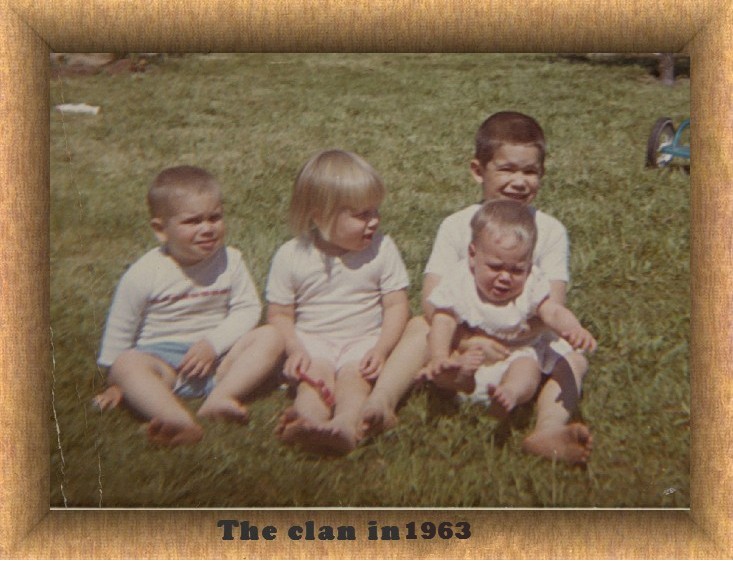
The house on Franklin was functional but that was about it. It was an old house with a pretty big back yard with a few filbert trees (bushes). The heater was an oil heater that was added later by building a small chamber under the floor in the living room and letting the heat come up through a screen in the floor (I think it was just convection but there may have been a blower). Birdie dried her diapers (we couldn't afford disposable diapers) on a rack that she put right over the furnace. We had periodic problems with the stupid oil furnace. I would complain to the owner and he would come by and work on it but he wasn't that competent. He never really found the root cause of its problems.
Christmas we went to Bandon and celebrated at both my parent's house and Birdie's parent's house. All three of my sisters were home.
My father told me a sad story about his concern that Maxine was going to get in trouble and she needed a different environment and asked me to take her to Beaverton to live with us. So, we did. Maxine was a big help with the kids and for Birdie who was pregnant with Kirstin. We got really attached to Maxine and wanted to keep her but with no financial help we just couldn't afford to do it and that summer we took her back. She finished High School in Bandon and later came back to live with us.
Matt grew and began walking about the time we had a new baby.
Kirstin came on the night the doctor was at his child's Baccalaureate and he wasn't real happy about being called in. But she was born and she was beautiful.
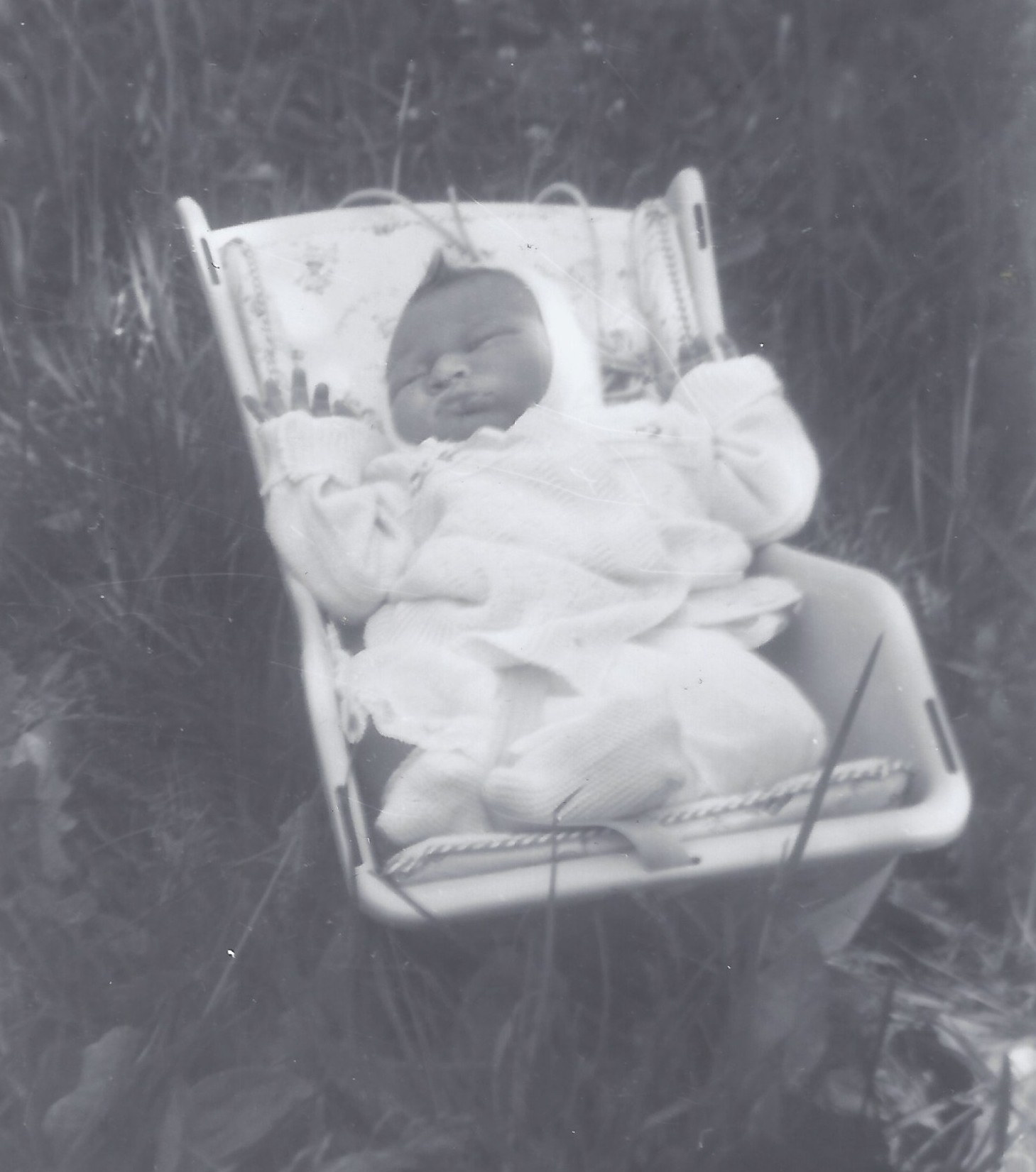
We thought we had this family planning thing pretty well mastered, boy-girl-boy-girl. Little did we know that we were just getting started and this would be the end of our perfect balance.
My school had gone fine the first year but many of the classes I needed to take had prerequisites that were not offered at night. I had taken calculus through a correspondence course but correspondence was not a good solution in those days. It was all by snail mail. You did an assignment and sent it in to the professor. A couple of weeks later you got it back, but in the meantime, I would have done a few more assignments and if I had gotten on the wrong track, I had a real set back. But I loved math and spent enough effort to avoid that. Since I had no one to ask questions, I sometimes spent hours on one problem. But it worked. But I talked my supervisor into allowing me to switch jobs with a swing shift utility man so I could go to school during the day. One class I needed was Differential Equations which was only offered during the day. Another was Thermodynamics. These classes were both taught by foreigners. Differential equations was taught by an old German. He would start his lecture on the left side of his blackboard and write equations with his right hand and lecture as he moved right and with his left hand, he erased just a little behind where he was writing, so you had to keep up or flounder. The first day of class he gave a calculus test and told us anyone who couldn't pass the test could go back and take calculus over. I got the top grade on the test and he asked who I had taken calculus from and was a bit surprised when I told him I took it by correspondence. The professor who taught thermodynamics was from China and his accent was so strong I had difficulty understanding him and certainly had trouble understanding thermodynamics, which was unfortunate since I ended up in process development work and thermodynamics was important, but never my forte.
A little summary of cars we owned during this time. We drove the hot rod 52 Chevy for about a year. The clutch was going out. To get it moving, you would let the clutch out and the car would sit still for a few seconds and then start very slowly moving forward. It didn't evoke confidence that it was actually going to go. So, I drove it to a used car place in Northeast Portland and parked along the street just outside the car lot. I looked around the lot and found a 1960 English ford that seemed to have the right combination of looking nice and costing little. I made one of my infamous offers to the salesman and he asked about my car. I said it runs good. We went out to my car and I was wondering what to say when we started to test drive it. He had me start it up and we talked a bit and he said, "OK" and got out. I told him I only had a limited amount of time and we needed to get the deal completed quickly so I could get going. I wasted no time getting out of there before they came to get the car. I never heard from them; the English ford turned out to be a good car. It was a bit small for our growing family but we made do.
While working swing shift that second year, I made two friends that were important. One (Robert whose last name I forget) was a dental student in his last year of dental school and was working as a utility man to finish up. He was one of the most naturally happy people I ever knew. He was constantly singing while at work. He and I talked a lot about working our way through school, he was finishing and I was starting, and he was a big encouragement. After he finished dental school, he opened up an office in Aloha and we went to him for dental care and took the kids. That was the last contact I had with him. Most of the women doing the assembly work were quite a bit older than me and I had little in common with them. There was one girl my age and she was working to put her husband through school. I don't remember her name but her and I spent quite a bit of time talking about her husband's school and my school. There was one supervisor on swing shift named Jerry. One day one of the older QA gals was walking down the hall during a break and heard some noise in a broom closet. She opened the door and there was Jerry making out with one of the assembly gals who was of dubious reputation. The job of the QA gals was to sample inspect the assemblies built on our entire floor, so they pretty much communicated with everyone. Well, she went back to her station and couldn't contain herself so she told one of the other QA gals the gory details of what she had witnessed. Unfortunately, this other gal misunderstood and thought she said, Gary! It spread like a wild fire throughout the entire assembly area. Afterwards, when I would walk up to one of them, they would start giggling and when I questioned them about it, they wouldn't say a word. I was really frustrated. Finally, I got my friend to tell me that this one inspector had said she caught me in the closet with this gal. I went and confronted the inspector and she said, "oh no, not you, Jerry!" I convinced her that it had spread that I had done it and she needed to help stop it and she did. It took much longer for the truth to spread than the original story. My friend's husband ran off with a coed on his graduation night after she had worked for years to get him through school.
During one night of that second year while I was at work, a storm struck Oregon and it is still the baseline used to measure storms in Oregon. It was Columbus Day and the winds were very high and lines were down all over Beaverton and the power was out. We were told to not leave the plant because of the danger of down power lines on the roads. However, I was concerned about Birdie and all the kids handling things at home, so I left and drove home. They were right, there were power lines down all over and I had to dodge around them and there were dead signal lights just swinging by a thread above me. But I made it home. At home the neighbor's large oak tree had fallen and the trunk had missed the house by several feet but a large limb had broken out one of the windows. Birdie had lit candles and found some cookies and had the kids singing songs, they got half a cookie and then sang a song and got another half. It kept them calm. We patched the window up best we could and rode out the rest of the night. Our power was off for about a week. It made feeding all the babies difficult since we had no equipment for cooking without power. After a few days some of the neighbors got power before us and they helped us out. Kirstin got really sick and Birdie had to go to a neighbor to call the doctor. That night while my car was parked at Tektronix during the beginning of the storm, pebbles that were part of the roofing on top of the assembly plants had blown off and pelted all of the cars in the parking lot making hundreds of pits in the paint. The top of our car was pitted and had to be repainted.
We had our first dog while on Franklin. He was a real cute little German Shepherd puppy. At first the kids loved him. As he grew and became a bit more boisterous, some of the love faded. Matt hadn't been walking long and was a little unsteady on his feet. The pup loved to make a run from behind him and jump up on Matt's back, sending him tumbling. He wasn't really a biter but he nipped one of Gilbert's kids and drew blood. We decided that was a bit much and since the paper boy loved the pup, we gave it to him.
Kirstin was beautiful like I said but we were so poor we couldn't afford many pictures or movies at that time so the record of her babyhood is limited as well as all of the kids at that time. One of the rituals at that time was baths. Birdie and I divided the tasks and it was like an assembly line. Birdie would undress them and send them to me and I put them all in the tub together and as they played in the water, I picked one and washed them. Then I dried them, wrapped them in the towel and sent or took them back to Birdie who put them in pajamas. This ritual was repeated through them all!
God took care of insuring we didn't drop our interest in Catholicism. First, the church, St Cecilia, was only a block away and they had hired a lay theologian. The lay theologian idea started in the San Francisco diocese where they set up a program to train lay theologians who could help with evangelism in parishes. Father Gerace, pastor of St Cecilia, hired Bob Greger from this lay theologian program. Bob Greger started what he called 'inquiry forums' and invited non-Catholics to come and learn about the church. Second, our neighbor was a sweet, elderly woman named Mrs. Gannon. When we were first moving in, Birdie needed to make formula for Matt and we hadn't gotten our stuff unpacked so she went to borrow a can opener. Mrs. Gannon was the only neighbor home and she loaned Birdie the can opener and came to visit her every day after. Birdie had talked to Mrs. Gannon about Catholicism and, although Mrs. Gannon was a protestant, she had a Catholic friend, Barbara Slapper, who had asked Mrs. Gannon to go to the inquiry forum. Mrs. Gannon said she would go if she could also take Birdie. So, they worked out the babysitting problem and the three went to the inquiry forum. Mr. Greger gave Birdie a lot of time answering questions. He then volunteered to come to the house and give me personal time to answer my questions about Catholicism. I had all of the typical protestant misinformation about the Church and he worked me through it all (Bishop Fulton Sheen once said that in America there were probably only a couple of dozen who didn't agree with the Church's teaching but there were millions who didn't agree with what they thought the Church taught!) In December 1962 we were all baptized into the Church, the kids first and me before Birdie- a fact which always gave her a chuckle when she heard that some relatives claimed she had drug me into the Church.
We joined the Church during the time of the 2nd Vatican Council that had been called by Pope John XXIII. One of the thrusts from this Council was ecumenism and one of the local responses was meetings called 'Living Room Dialogues'. These were a few couples of different faiths getting together to talk about their faiths and what they had in common. Birdie and I became part of this. I think we met about once a month and the other three couples were different protestants (one Methodist and one Lutheran and one was a fallen away Catholic) and one a longer time Catholic. We enjoyed it and the discussions were good. The fallen away Catholic was a bit of a pain, but most of them are because they have fallen away because they couldn't (or wouldn't) live by the principles and they feel a need to justify it. One fellow started out saying he only came because his wife made him and he was grumpy and out of sorts for several meetings. He got so he was into them more as time went on and he came back for the second year. The Methodist liked to do wood work and he had a large corner end table he had made for his daughter but he thought we needed it more and he wanted us to have it and we had it and used it for years.
Birdie and I had struggled with the house on Franklin. The landlord would fix things eventually but he grumbled and stalled. I don't think he ever replaced the window that was broken out in the Columbus Day storm. So, we started thinking about buying a house. The problem was we had no money. But such things don't deter a good realtor and we got in contact with a good realtor. He proposed we could buy a house he showed us on 11th Street. The owner had moved to somewhere like Medford and was anxious to get it sold. The realtor inflated the price enough to cover the down payment and the owner got what he wanted and we got in with no down payment. When we had looked at the house, the renters had rugs down in all the rooms. The house was what was called a slab house; i.e., it was built on a slab of concrete for the floor.
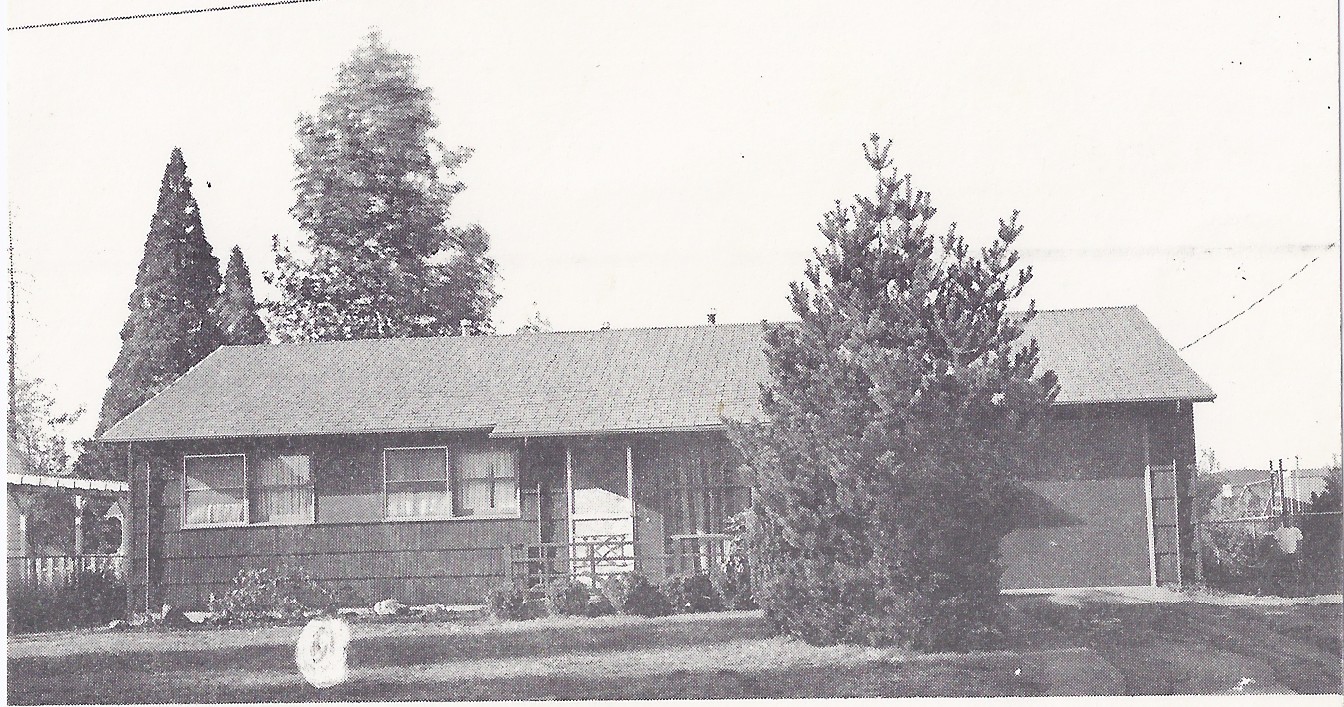
The outside perimeter of the house was on a deeper concrete foundation and the slab poured inside level with the top of the foundation. The walls were based on the foundation. The slab in this house had pulled away from the foundation, leaving a crack about two inches in from the walls all along the perimeter. That was what the rugs were for, to hide this. But we had it and our clan enjoyed it for several years before moving.
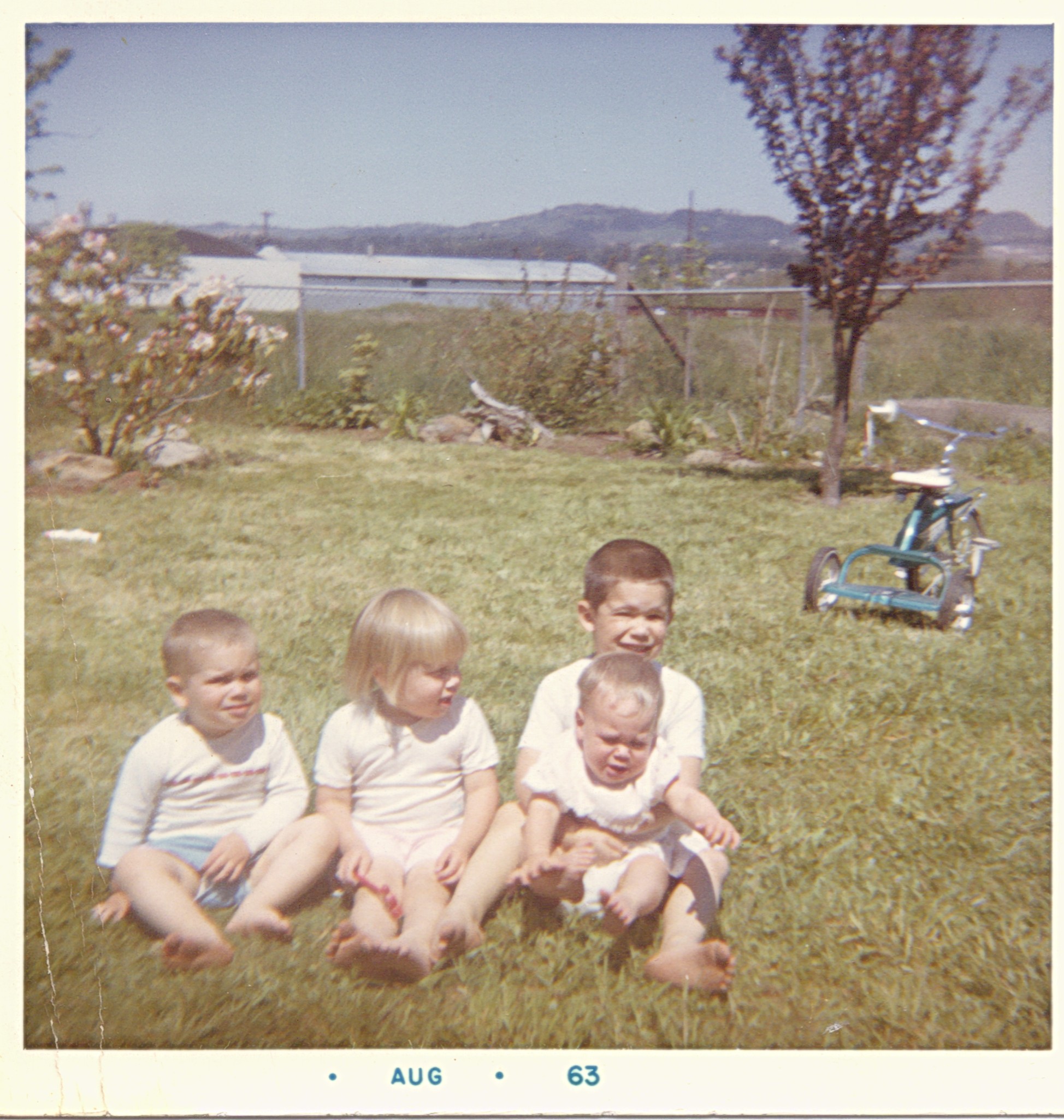
And guess what, we had another baby on the way.
You would think we would be getting good at this having a baby thing, but no. This time we were at St. Vincent's hospital which at this time was in NW Portland on the hillside on the edge of town. I was in the waiting room with Birdie when her water broke with so much force that the blankets were lifted up into the air. In a bit of excitement (not panic!) I had to get the nurse. Michael was born soon after.
He was a beautiful baby. We soon had
And with five hungry mouths at the table. I needed to get moving upwards at work.
After I had been a utility man for two years and had done pretty well at that and had two years of school, I applied for some openings that came up for process technician. I was hired into what was called the "Tube Lab". This was a small group of technicians and select operators who built prototype cathode ray tubes (CRTs) for the R&D engineers who were developing new CRTs. This move would get us a little more money over time but it also got me started in the process development work which would be my career. One of the interesting things in the tube lab was a hydrogen furnace that sat in the middle of the room. It was my first experience with hydrogen. The furnace had fires going on both ends to ensure no hydrogen got out into the air, which would result in an explosion!
Note: For those who would like to read the gory details of my work at Tek , I will put in an addendum titled: 'Work at Tek' with some technical information on oscilloscopes and cathode ray tubes and my work in the Tube Lab. The link is later in chapter 5 and covers all my work at Tek. There is considerable redundancy between the work paragraphs in this, the chapter 5 story, and the 'Work at Tek' addendum.
We had some of our most memorable years on Eleventh Street. We didn't have much money so we found inexpensive things to do. One of the first projects was to clean up the back yard. It had a nice cyclone fence but the prior residents had just thrown their garbage in the back yard. There was an old ceramic double sink and some large metal scraps. We didn't have a clue what services might be available to get rid of it. So, I dug a huge hole in the corner of the yard and buried the larger stuff that I couldn't fit in the regular garbage. We couldn't afford to reseed the lawn so I gradually weed killed and fertilized until we had a nice backyard for the kids.
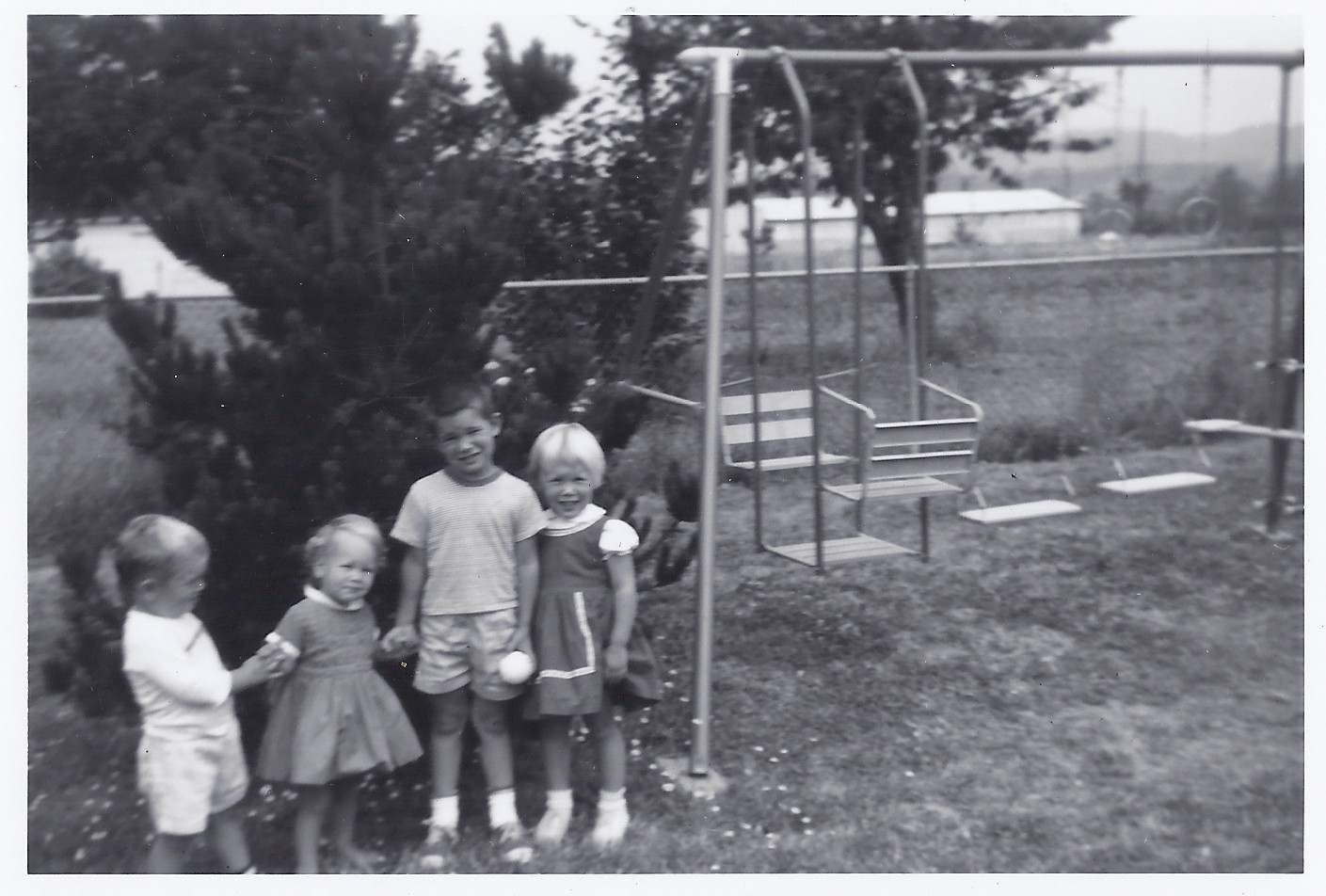
We also got some gifts that helped a lot. One was a tree for Michael from Auntie Ruth. The backyard had a flowering plum and a pine tree and a couple of birch but they were so small they didn't provide any shade. So, I went to the nursery and asked the owner what he recommended for a fast-growing shade tree and he sold me a Carolina Poplar. It did grow fast. He recommended I put bone meal in the hole to get it going. I did and it did and it became clearer every year that I had planted it too close to the house. Fortunately, we moved out before it became a total catastrophe. We lived there for just six years but it had grown big enough that we took a picture of Michael up in the branches. Years later when we came to see the house the tree was enormous and just dwarfed the house. A few years later they had removed it, all except for a huge stump.
Auntie Ruth gave the kids a wading pool. It was big enough (probably about 5'X8') for them all and was a pretty good pool. The liner was really good, in fact, and the only weak link was the four metal legs for each corner. I soon discarded them and made a frame out of galvanized steel pipe. It lasted for years and gave me some experience in plumbing that was about to come in handy.
Another gift was the whirlibird which Grandpa and Grandma Leppert gave the kids.
It had four arms that extended about four feet out from the center. Each arm had a seat on the end and both handles and pedals that could be pumped to make it move. The harder you pumped the faster it went and you flew around in a circle. The kids would keep it going until
they got sick and had to get off and puke! Sometimes, that is, they got off before. We tried to watch and keep them taking turns enough to avoid getting too sick but they loved to go! We also combined all of their birthday money one year and bought some bars. It was several levels high and was a matrix of bars.
The danger was that one of them could drop from the top level and free fall all the way until stopped by the head hitting the ground. We never lost one, that I remember.
We had almost continual birthday parties, six from Paul's birthday on 17 April to Teresa's on 4 June (seven if you count mine). Besides getting sick of birthday cake we had to come up with entertainment. Birdie was creative. She came up with noise and
with games
and with sunglasses
I had borrowed from the Soviet leader, Stalin, the idea of 'five-year plans'; although I had modified it and set an eight-year plan for me to get through school. Stalin's understudy and the premier of the Soviet Union, Nikita Khrushchev (1958-1964), once said that they would bury us. Later he stated: "I once said, 'we will bury you,' and I got into trouble with it. Of course, we will not bury you with a shovel. Your own working class will bury you." While we were keeping our eyes on the Soviets, our own government under Lyndon Johnson was sewing the seed of our destruction. That seed is called entitlements! Fortunately, the concept was too late for me and I still believed that in America you could be or do whatever you wanted as long as you had the talent and the ambition to pull it off. Fifty years after Khrushchev and now he looks like a prophet.
A couple of incidents that occurred during this period. We took the kids to the parade they had for kids the day before the Rose Parade called the Merrykanna (sp) parade. It was pretty crowded. One year we went with Grandma and Grandpa Leppert. After the parade had passed us and the crowd was on the move to get out, we started gathering up our clan and discovered that Teresa was missing. We had thought that she was with Grandpa and Grandma and they had thought she was with us. We were in a panic and immediately started the search. The streets were full of people and she was little. Finally, we found her waiting. We had taught our children that if they got lost, they should just stay put and let us find them. I guess she remembered the lesson. We were thankful we found her. After all, it's not every Halloween you can find a little girl witch in the pumpkin patch, especially a cute one.
On 14 April of 1962 a huge birth occurred in Portland; the birth of the first elephant born at the Portland zoo and the first in the US for several decades. The baby was named Packy and was the big thing in the local news until six weeks later when Kirstin was born. This was back before local government had discovered that their sole function was to find ways to collect more money. In those days they actually did things that would make the community better. One of those things was to open the zoo up Saturday morning FOR FREE. This was a magnificent practice and allowed thousands of children (and parents), who normally would not have a chance, to learn about and enjoy the animals. Included in this was our family
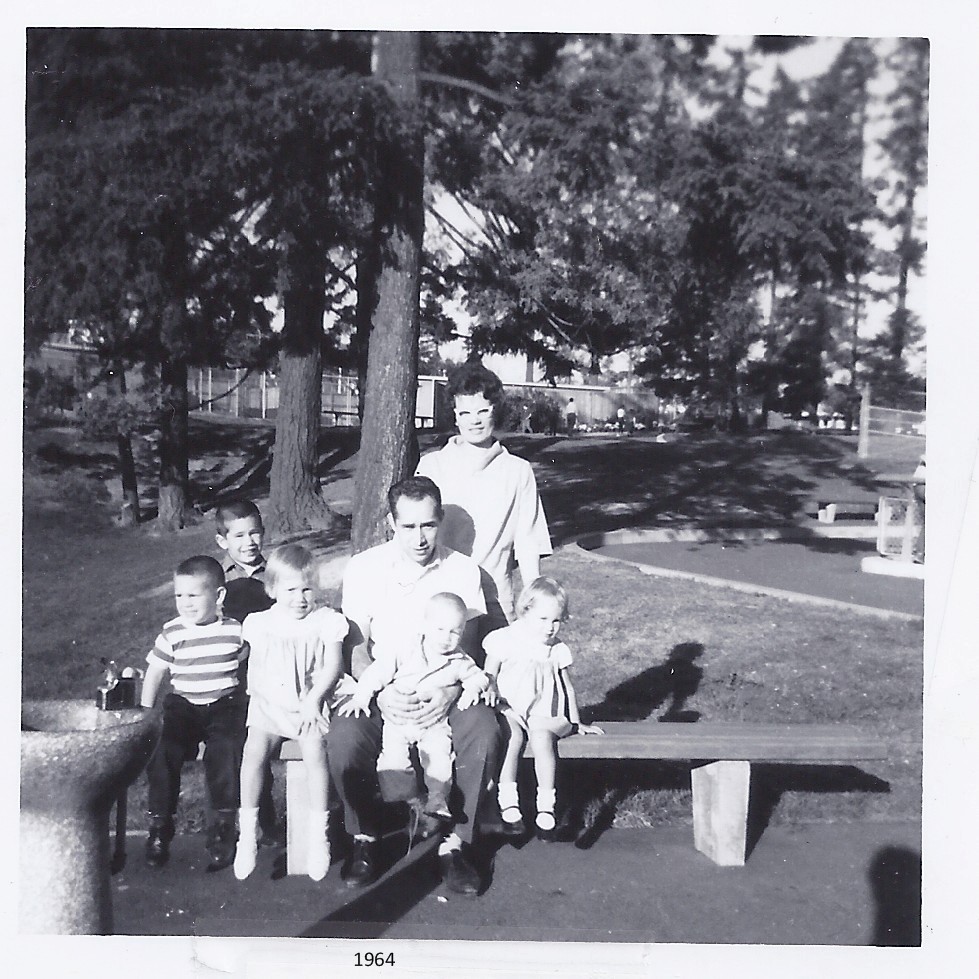
We visited the zoo many times including this time with Gilbert and his family.
We had some memorable experiences. The zoo had recently moved to the location on the hill and the facility was nice. We usually visited the animals and then took a ride through the woods to Washington Park and back on the train. They built a particularly good penguin display. There was a pool of cold water and some rock ledges the penguins could walk on and dive into the pool from. When Kirstin was about two or three, she walked good enough to be independent but usually trailed along behind. When she saw the penguins, she immediately concluded they were "ducks"! No amount of persuasion deterred her. When you told her they were penguins, she just defiantly said "duck!" Maybe we should have noticed a personality trait here. Mom even suffered through the snake displays although she skipped around them as much as possible, sending her unsuspecting husband and children amongst the vipers. I think Matt was probably the only one who really was able to look at them without warily thinking through the possibilities that one of them might get out. Packy was cute and grew along with our kids. The giraffes were friendly too as long as you had food to feed them!
I always thought that flying a model airplane would be fun, so when Mark was within two or three years of being old enough, we bought him one for his birthday. The only reasonable place to learn how to fly was in the back yard. This model airplane was controlled by wires from the wing and tail to a little paddle that the pilot held. Being navy, I of course thought it should fly off a carrier. Well, that was the story made up to explain why we needed to fly it off the picnic table. The real reason being the yard was so rough that plane couldn't get up enough speed for take off before the prop nosed into the turf. The birch trees and pine trees in close proximity to the planes path added some challenge to the task. We did get the plane off the ground several times and the mean time between crashes got longer and longer and may have approached half a circle. Eventually even my engineering skill was not up to the task of keeping the plane flyable.
Another favorite outing was the beach. The price was right and it was cool and fun, sometimes too cool but that just reminded me of why I didn't like living on the coast, it is windy and cold! Keeping tabs on the clan at the beach was a two-person job, at least. But we had fun and never lost a one, our primary goal as parents.
One of the problems with the slab house was that the water line ran under the slab. That made it more economical to build but consequently was pretty impossible to work on. Since water pipes are normally very reliable this was not a horrible trade off. However, our water line started leaking and it started leaking under the center of the house. I don't remember how we discovered it was leaking but it presented a pretty formidable problem for a soon to be novice plumber.
The water line went under the slab and came up in the center of the house and connected to a junction of the hot water heater and the two faucets (bathroom and kitchen) and also a line to the back yard faucet which we had made into a fountain so the kids didn't have an excuse to come in every 7.3 seconds for a drink. So, I decided on an engineering solution, I would connect a new pipe outside the house and run it up the side of the house between the siding and the drywall into the attic and crossover in the attic to the center just above the water heater and then back down into the house and connect it to the junction. So, I bought a pipe wrench and some galvanized pipe. I dug down to the pipe several feet from the house, cut the pipe and threaded it with a tool I rented for making pipe threads. All of the fittings were threaded and it worked as planned. It had to be done quickly, since we were without water while I did it, meaning laundry was piling up, a crisis in our house. Soon we were back with it all connected up and working. Over the years Birdie and I have often wondered if that pipe in the attic ever broke or froze (it was bare pipe in the attic about two feet above the ceiling). It would be pretty catastrophic. But while we lived there, it worked and that was all that we needed. I still keep the pipe wrench as a memory of my one week-end plumbing intern program.
It was a problem keeping tabs on six children with the oldest barely six. Sometimes we didn't. Often, we got help from people in stores who would count in astonishment as we went by. One near miss was a time we were getting loaded up to go somewhere and we didn't count. We pulled out of the driveway and started down Eleventh Street and I checked the rearview mirror and there was Matt trying to pull up his pants and at the same time run down the street to catch up with us. He had been in the bathroom when we loaded up and no one had noticed. As best we can remember we never lost any permanently.
We tried many things and mastered few. One we tried was flying kites. We bought the kids kites and flew them in our yard, in the field in the back and in the street. I think it was Matt who wanted a box kite and we bought one and it flew really well, too well. It took off and went up high to the end of the string, and then it just kept going. We never found where it came down but it was probably somewhere in Washington County. It was going great the last we saw it. Matt was left with a just a broken string and a bewildered look.
Every child needs a bicycle. So, we bought a used (up) bike when we thought Mark was old enough ride. I fixed it up and painted it. Of course, tested it personally for safety.
Then I spent what seemed like hours walking or running with Mark to keep him stable until he mastered it on his own.
Later we were able to splurge and buy new bikes and it was the hit of Christmas morning to see a huge box all wrapped and setting next to the tree with your name on it. The first time there were three and then Kirstin and Mike followed as they were five. Mike mastered it and his younger brother, Paul,
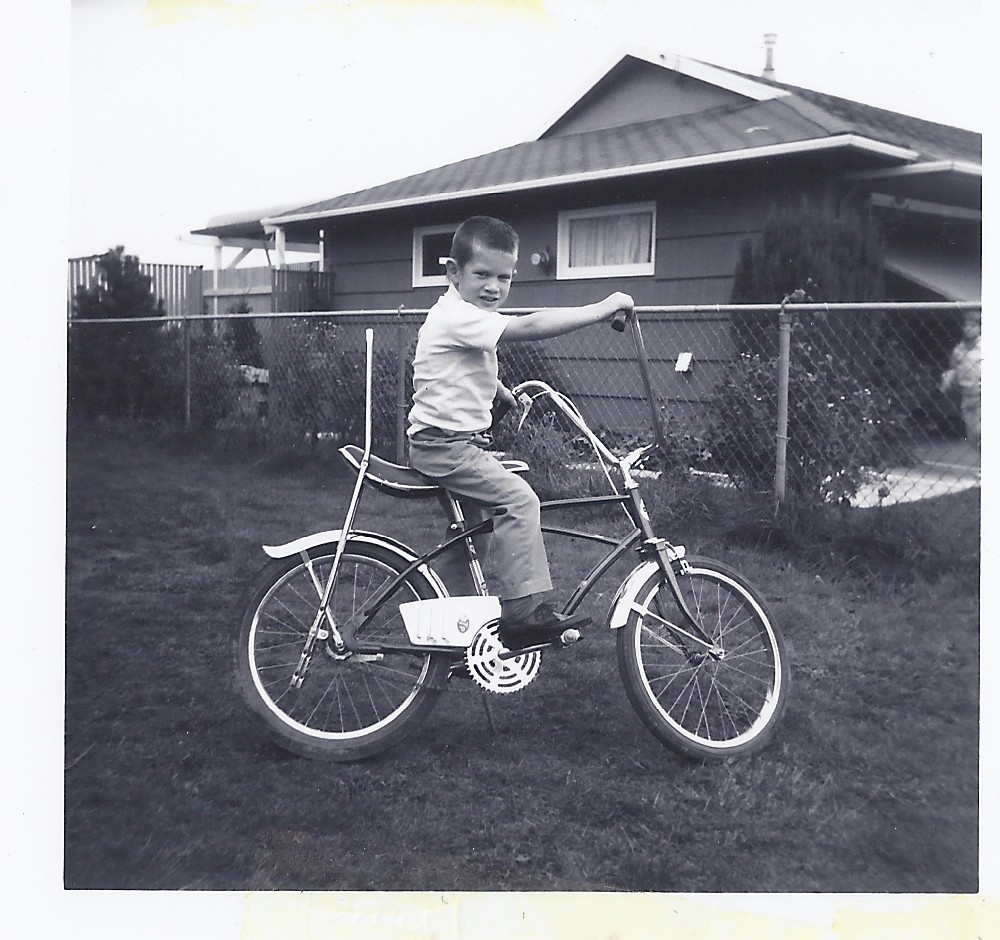
thought he should do whatever Mike did and before we knew it, he was giving it a try.
All of our children were of course talented and no doubt could have made it as movie stars had they been inclined. Birdie did her part by getting them started on the
Heck Harper show. But alas no contracts for our child stars came from it.
We had an occasional injury and I completed my internship in short order and was qualified to handle all emergencies short of invasive surgery. I was known as 'Doctor Dad'. Kirstin was a climber from the start and managed to break an arm a couple of time by the time she was eight.
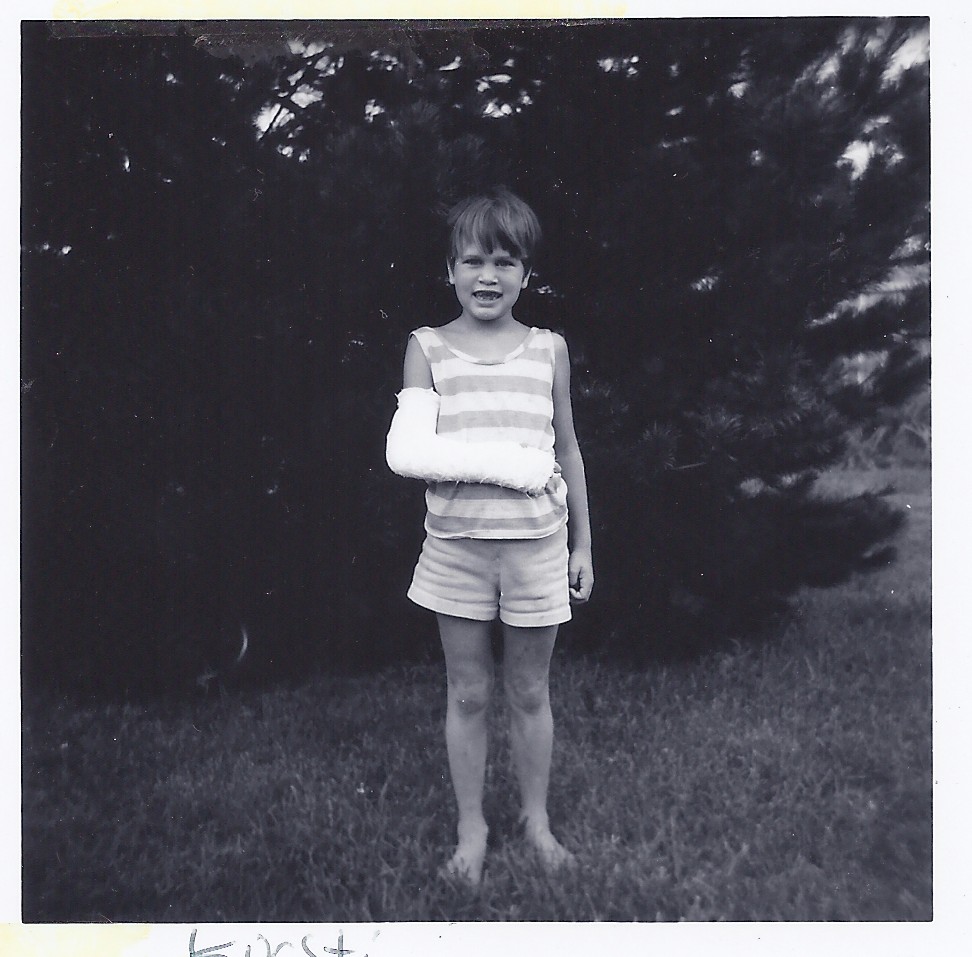
Birdie always felt she missed out at times because she didn't know how to swim very well. So, she spent hours at pools where our kids were getting lessons. Having many kids means this lasted for many years. I doubt neither the kids nor I realized at the time the sacrifice it was but thinking about it now, I can visualize her sitting around the pools watching swimming lessons for hours and hours. It paid off; they all swam good and some real good.
We always had time for Santa Claus and Christmas. Beaverton always had a display and place for pictures. Here is one of Paul in 1966. Not all visits were enjoyed by all.
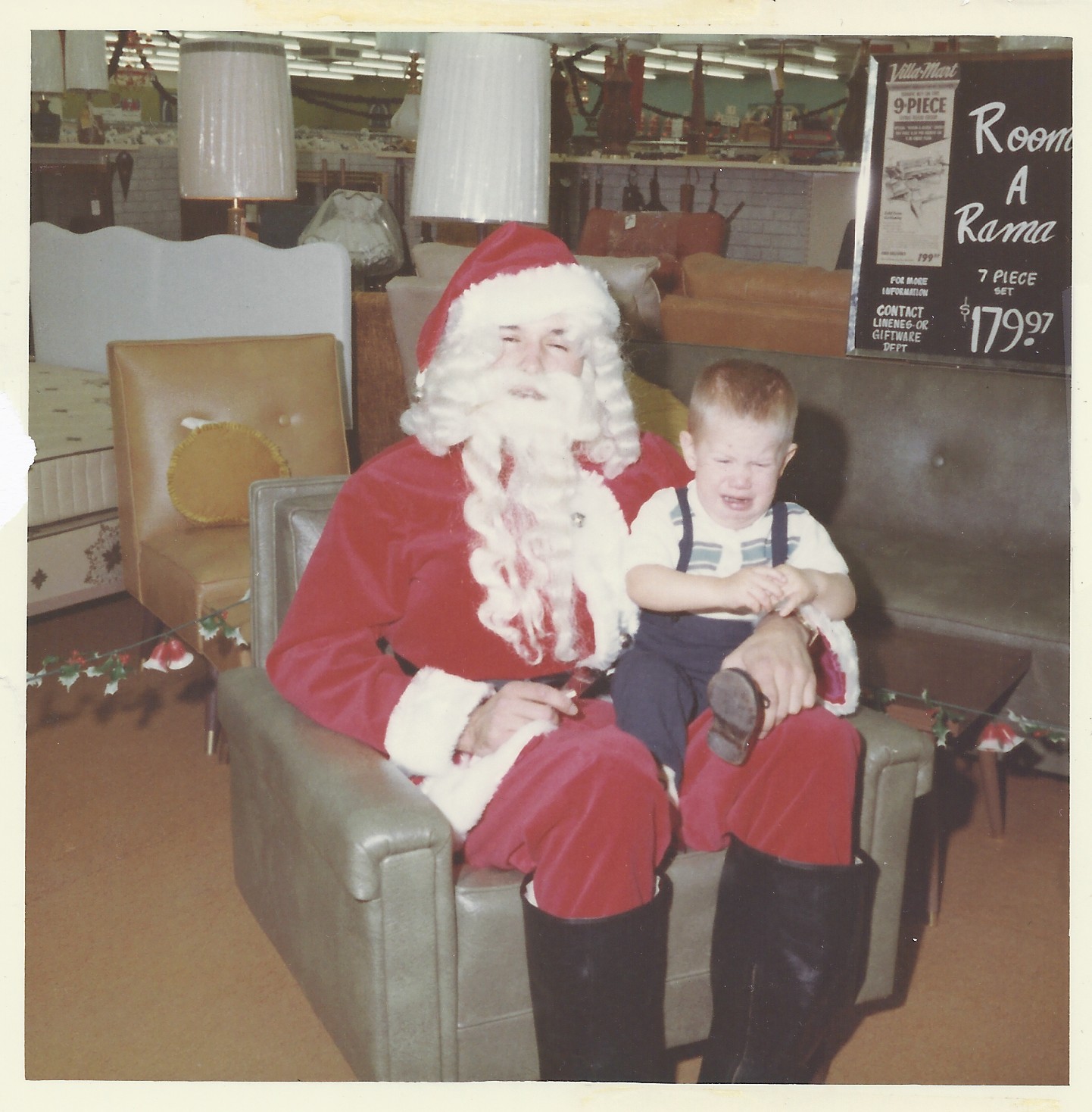
But we spent much time there over the years and have many pictures; some crying, some happy and most serious.
During the times I was going to school I didn't have much time for anything besides work and study. But I took summers off and we tried to focus on doing things as a family. Since finances were thin, we looked for inexpensive things to do and one of these was picnics. Birdie remembered going to Merwin dam for picnics when she was little so we went the first time mostly to refresh her memories. But it was pretty ideal. A large field for games, a nice swimming area, tables under the big fir trees for picnics and a trail we discovered for hikes.
to the 'waterfall'.
The swimming area was good in that it had a shallow area for the swimmer 'want a be' and a platform anchored offshore just far enough to be a challenge for the older children (and parents).
Sometimes the new swimmers became a little cocky and had to be made examples of!
The waterfall turned out to be a creek that crossed under the road in a metal culvert that emptied on some rocks a few feet below. It was our waterfall and every visit included the hike.
A couple of times Gilbert and his family went to Merwin with us and once Lucky and Rosie. Those memories of our young family at Merwin are special.
Our years on Eleventh Street were poor years. Birdie babysat to make ends meet. One of the mothers she babysat for was named Donna. Her husband was in the Air Force and was in Viet Nam. They sent him to Hawaii for R&R and Birdie took care of their kids so Donna could join him. Donna brought back a pineapple that was the best one we ever had in our lives. Sometime after this as a special thank you, Donna's Aunt & Uncle offered us the use their cabin on the beach for a few days. The cabin was in the 'Roads End' section of Lincoln City and was a nice beach cabin that sat back about a block from the beach. We enjoyed several days there. A couple of things stick in my mind. First, Teresa was sick most of the time we were there and she wore her coat at all times and didn't really enjoy the time. Second, we harvested
star fish, one per!
We weren't sure what we should do with them to preserve them. So, we thought the most humane thing was to throw them in boiling water, cook for three and a half minutes and let them dry out. The more they dried the worse they smelled until 'Super Nose' demanded they be gotten rid of. People are no longer allowed to harvest star fish. Some think this is to protect an endangered specie but the reality is it was a coalition of mothers who didn't want the special preservation process we had discovered to occur in their homes.
It seems I kind of got ahead of my story. When Mark was five he went to Allen Avenue Kindergarten, as did Teresa and Matt when they were five.
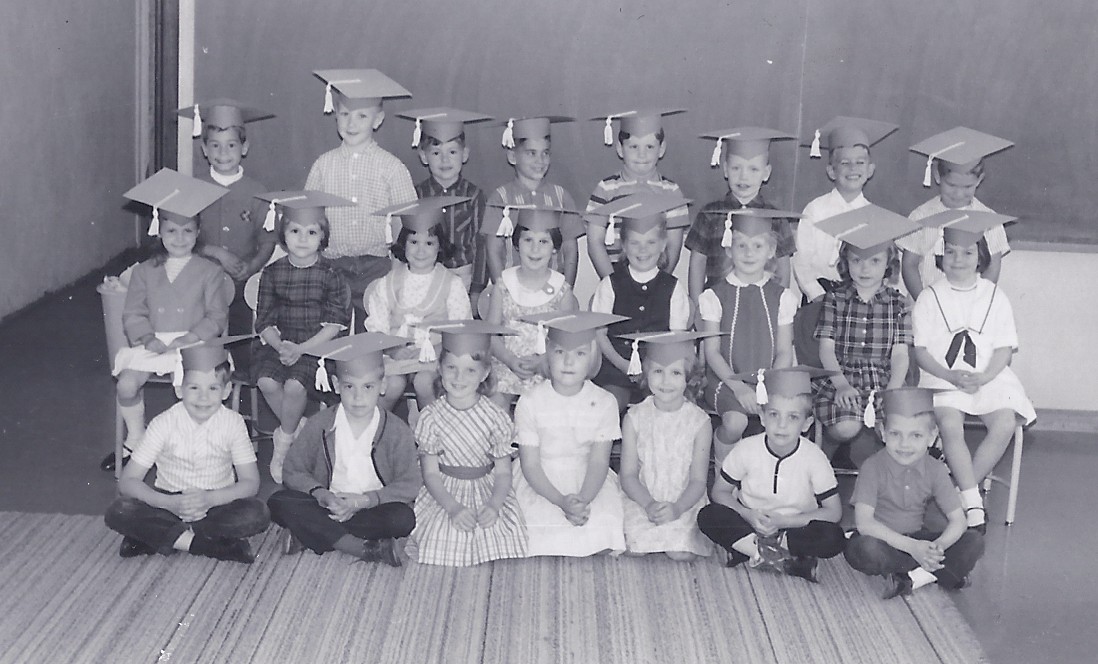
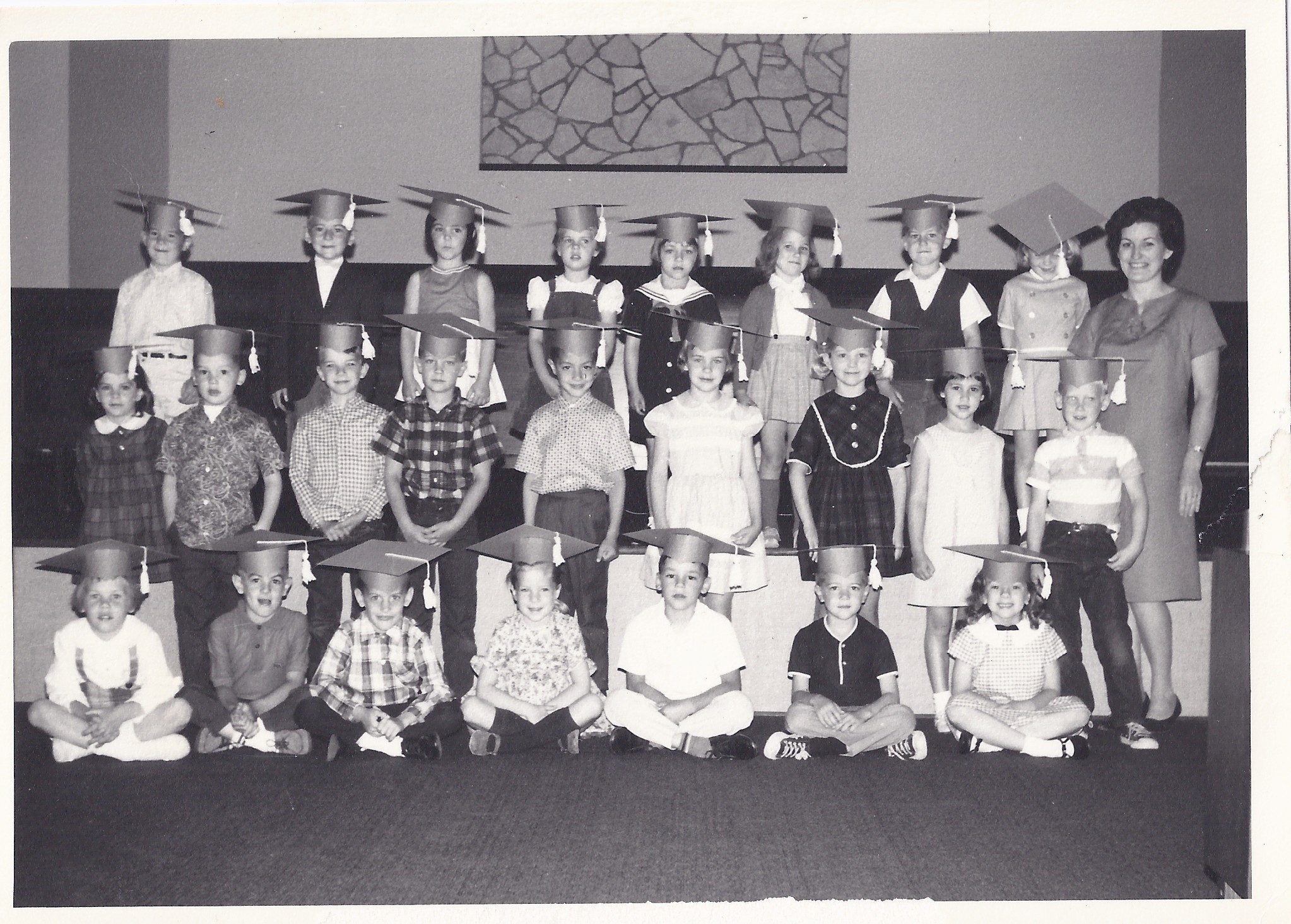
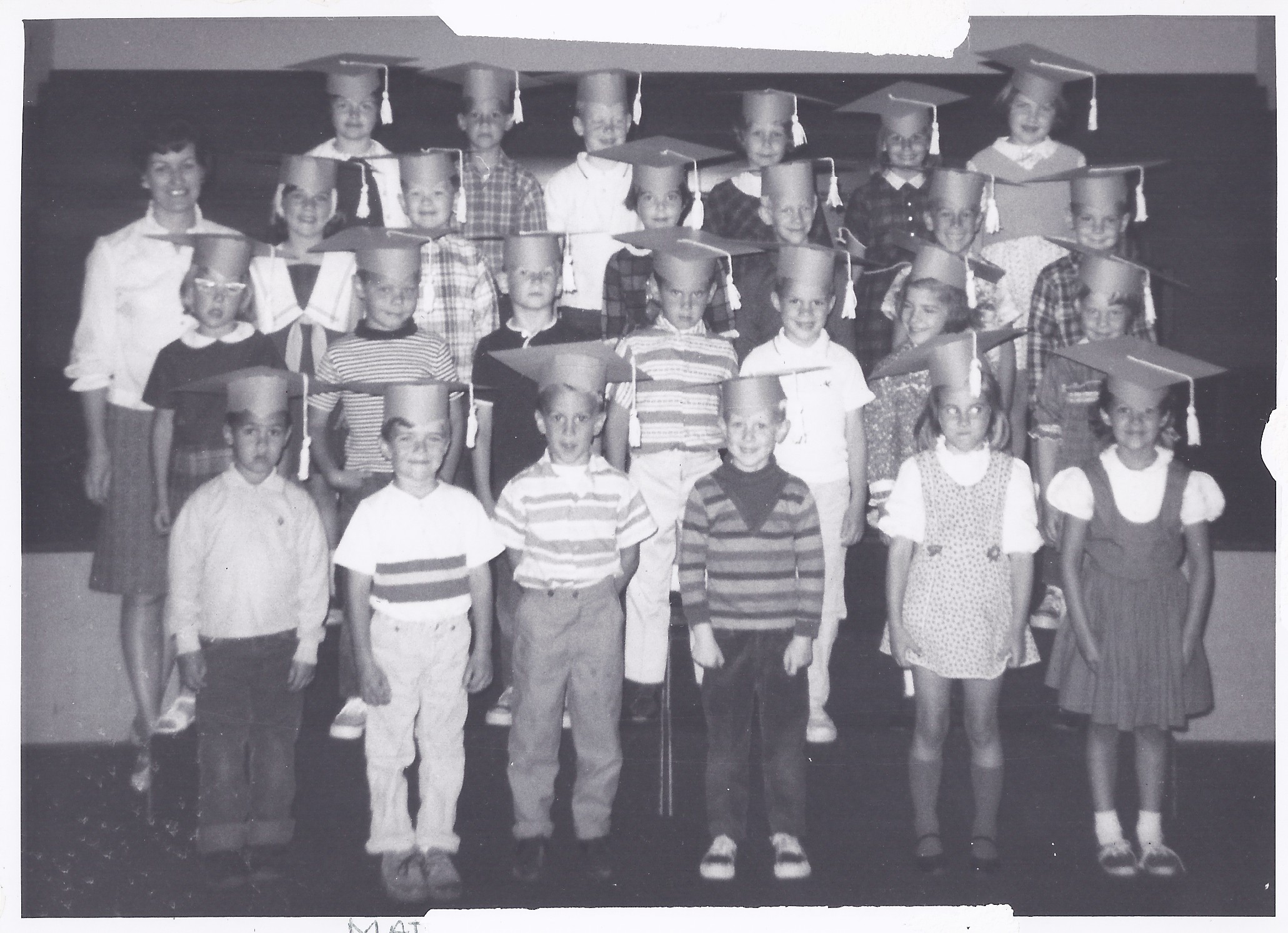
Eventually also Kirstin and Mike also attended. It was only a few blocks from our house on 11th Street. Allen Avenue then was a narrow two-lane road and we had no idea it would become a major boulevard in Beaverton. Mark was a bit shy in kindergarten, he was the donkey in the Christmas play and he hid behind the stable and we could hardly see him. After Kindergarten, they went to St Cecilia
In those days the catholic schools required uniforms, but we thought they all looked dashing in their uniforms.
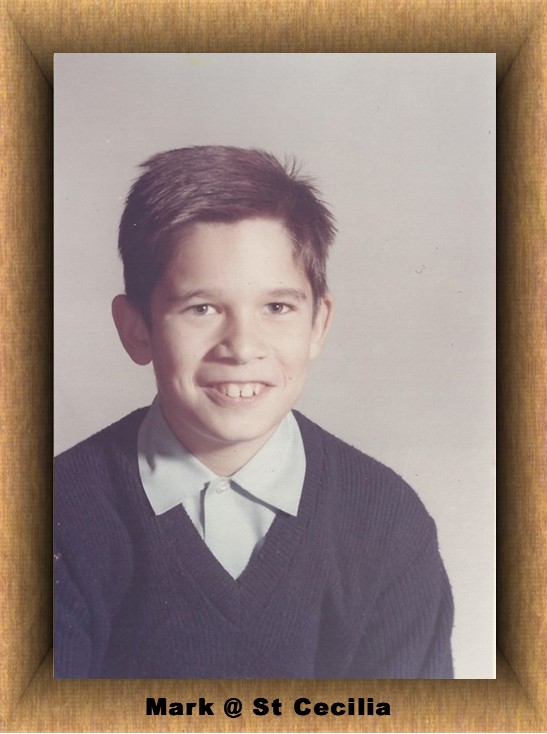
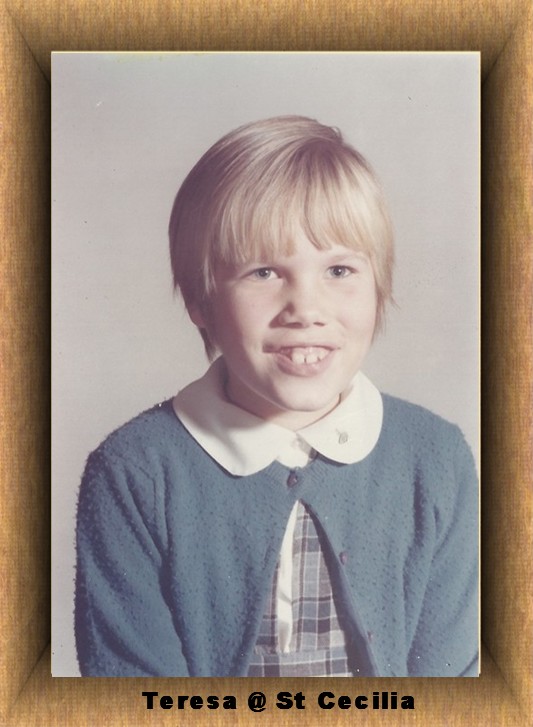
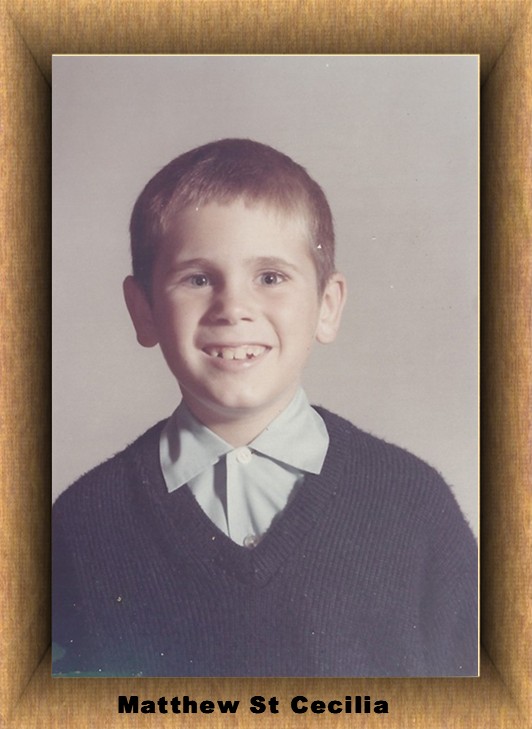
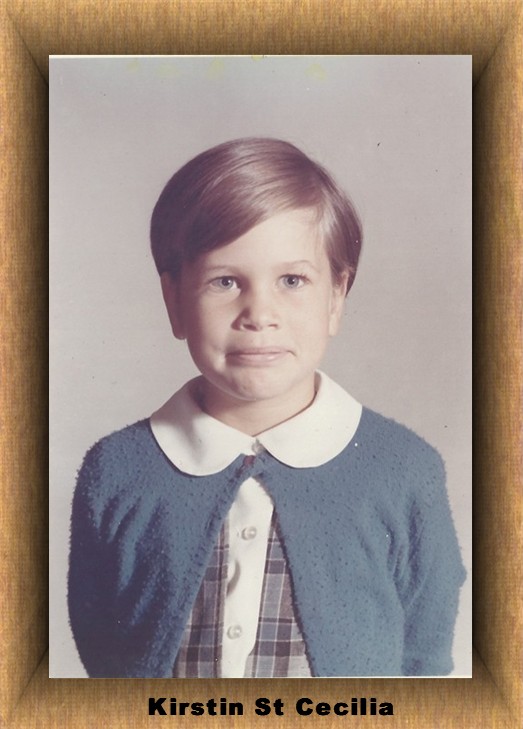
Mark's first grade teacher was Sister Rita Rose and she was young and just getting started in her teaching career. Mark liked her a lot. I don't remember Teresa's first grade teacher but I remember when we went in for the first parent teacher meeting. I suspect it was after about two months of school and we asked how Teresa was doing and she told us she didn't know since Teresa hadn't talked to her yet. Sometime after that the ice was melted and it has never come close to freezing again. When Teresa was in first grade, we had problems with constant sore throats and Doctor McDonald finally said he thought maybe some of the kids were passing it around and he recommended taking out tonsils of Mark, Teresa and Kirstin. We agreed and it was done. In the hospital they put them in a room with a poor moaning, groaning woman that scared them so we had them moved. After that they all healed up and we had no more than normal problems thereafter. The doctor was right.
We made several visits to The Grotto – a good place for six wild kids to roam.
.
Also, about this time someone invented the 'slip n slide' and we tried that, that is we tried the kids on it. We did not try it! They had fun.
School was progressing according to my eight-year plan. After a couple of years in the Tube Lab I moved into the Process Development Group as an Engineering Assistant and worked on development for a new storage tube. The project manager was Pierre, an engineer from France. The innovation for this CRT was using a hexagon thin film gold matrix on the glass faceplate rather than the solid transparent indium/tin oxide layer as the conductor/collector. The gold matrix would allow use of more efficient but conductive P31 phosphor. The phosphor was photographically deposited in the bare areas within the hexagon matrix with the gold thin film acting as the photo mask. The trick was to get the solution of photo sensitive Poly Vinyl Alcohol and phosphor to stay in the clear areas and wash out over the gold hexagons so the gold could act as a collector for emitted electrons. I was assisting the process engineer and his process for clearing the gold after the exposure was to manually move the faceplate under a faucet and visually determine when it was cleared enough. There were problems with uniformity and repeatability and I seemed to have an innate sense of what would work in manufacturing and what wouldn't. This wouldn't! In my spare time, I built and experimented with a rinsing device that allowed the water to come out in a broad, thin layer like a waterfall and the faceplate was rotated under it with a motorized lazy Susan device that had been made for applying photo resists. It worked pretty well but the process engineer wasn't very interested. So, I drew up a sketch of the device and showed it to Pierre. He was impressed with my innovation and furious with the process engineer. The technique was further refined and became the standard in manufacturing. Meanwhile, Pierre convinced me that I could move ahead in my career as a technician much faster if I took a couple of courses he recommended: technical sketching and technical writing. These were classes taught at Tek and not college courses. I took a year off of my eight-year plan and took them. I forever after regretted this. The courses were great and helped me in my career ever after, but it cost me a year in my program and that wasn't worth it. I needed to get through and I should never have lost sight of that priority. I was able to recover but not without pain. The storage tube turned out to be not that big of an improvement and it never went anywhere and neither did Pierre. A year or so later he was out of Tek and off on some scheme to pressure treat fence posts in eastern Oregon.
My next assignment was in a development team for a large storage CRT for use in a concept for a computer station that Norm Winningstad envisioned. At that time (only a few years after invention of MOS devices) storage was an issue, even enough storage to refresh a display. I doubt anyone envisioned the evolution of low-cost mass storage of MOS devices that would eventually dominate this area. Norm proposed that TEK's bistable storage would be part of the solution and he led the development of the large screen storage tube. The idea was that the computer could write the screen once and then be freed up to do other things. It hit the market before the widespread use of computers and was initially a limited success but over the next few years, as computer use exploded, this bistable storage monitor did very well.
The team developing this monitor included a few engineers and three of us engineering assistants; myself, Bill Mason and Jerry McTeaque. Bill was going to school to get a math degree and he did a lot of the test and measurement for the group. Jerry was our expert in photo processes. We were good friends and spent some of our free time discussing the theory of bistable storage and some learning to play bridge. Another friend of mine, Ed, who was a technician in a different area, and I became partners in bridge. He and I read a book on a new scheme of bidding featuring the 'weak 2" and we adopted it in the lunch time games as we tried to master it. After we learned the game a bit with our lunch time playing, we entered some TEK sponsored bridge tournaments and in one large round robin, Ed and I won. We even got some masters points! The main thing I remember about Ed was he had an old van and, in the back, he had this huge rock (three of four feet in diameter) he claimed was jade that he had found somewhere in Oregon and he would have a fortune when he figured out how to saw it up. He was working on some scheme to use bicycle wheels and piano wire. Hopefully he was successful but the last I saw Ed he still had the rock in his van. It was interesting to me also at this time that Bill and I discussed the theory of bistable storage on an equal basis, but when he got his degree a year before me and was promoted to engineer; he decided that his ideas were right and should not to be debated any longer. Maybe it was because Ed and I won more bridge masters points than he and Jerry.
I was developing a career concept that went like this: once you have spent two years in one position you have learned most of what you will learn and you have tried all of your ideas and incorporated those that worked and discarded those that didn't and it is time to move to something new. So, I moved into a group that was called Advanced Product Development. I had worked with, became friends with and played golf with an engineer named Jon Reed. He drove an old 1957 Chevy station wagon that he thought had some classic value. One day he drove into the parking lot and while sliding into an empty parking space he carelessly sideswiped the car next to him. It was locked and he had no idea who it belonged to so he left a note explaining what had happened and who he was. Well, it turned out the car belonged to Bill Walker, the vice president of R&D at Tek, and he was impressed with Jon's honesty. As a result, Jon moved quickly from engineer to project manager and he hired me.
One of the engineers that had been working in the group that Jon took over was Wes Hayward and he was working on concepts for high-speed storage. It was known that magnesium oxide had a high secondary emission ratio and when it had been added to P1 phosphor it increased the writing speed of bistable storage. Wes was working on a concept of using a thick, low density layer of magnesium oxide deposited on a mesh and transferring the image to the bistable storage phosphor layer. The problem was that bistable storage devices were notoriously poor in brightness and this concept, although making great increases in speed, seriously deteriorated the brightness problem to the point that the images on Wes's devices were only barely visible in a dark room. I proposed to Jon that we could possibly get the best of both worlds by adding another mesh with a bistable target and using the transmission storage concept to increase the brightness. Wes was more interested in understanding the writing speed parameters and not in developing a useful device. So, Jon gave me the project, unique since I was not an engineer, yet! For those interested in the gory technical details of my work at Tektronix, I have put it in the 'Work at tek' link, For the rest, on with the story.
The first stage was to develop the magnesium oxide process. The goal was to deposit, on an electroformed mesh, a layer of magnesium oxide about one mil (25 microns) thick with a low density (I have forgotten just what the density was, I believe near 5%). This was done by depositing magnesium in a low partial pressure of argon and then oxidizing in an air bake. I had a technician working with me doing these depositions. One time she was cleaning out the deposition chamber with an Electrolux vacuum cleaner. Not a good idea since the fine particles of magnesium accumulated and when you added some heat and a spark from the electric motor, BLAMM! My technician was not so enthusiastic after the vacuum cleaner was blown apart. But we worked out safe cleaning procedures and the process controls on the deposition and she was soon building consistent high-speed targets.
No one had ever built a bistable device on an electroformed mesh. A bistable target needed to be a high-density dielectric. I took on this task and investigated several ways of depositing dielectrics on electroformed mesh, including spraying, electrophoresis and I don't remember what else. The other constraint for any device for a CRT was that it had to withstand high temperature processing and it could not emit any gases after the CRT was sealed. I ended up with a process that deposited silicon dioxide on the mesh and when baked, it cracked like a mudflat and was an ideal bistable target. I don't remember which process it was, I tried many.
A second part of my project was to build these devices and test them. Prototype CRT's were expensive and the availability was limited, so we built very few and did a lot of testing on each. The CRT's were built in the tube lab and the first few had Gauss meters for measuring vacuum attached to them and these measuring devices could also be used to do minor pumping if the CRT became "gassy". I had support in putting together test equipment but the testing was all done by me. The electrical pulsing of the device for transfer from the high-speed target to the bistable target had been worked out by Wes but the operation of the bistable target as a transmission storage device was novel and I spent a lot of time doing that.
return1
Back at school, I had fallen behind. To finish on my eight-year plan I needed to go full time (take 19 hrs per term) for the last year. Jon agreed to my proposal to go to school full time and work 25 hours per week. I had some tough classes, including Modern Physics and Modern Physics lab, but we were off and running.
My sister, Maxine, came to live with us again after she graduated from high school. She became our first convert.
She got a job working at Tektronix, joined a bowling league and met Gene McFeron. Gene had a vintage red Corvette and was very protective of it. During this time (fall of 68 when I was going to school full time and my parents were living with us and Karen was in the hospital) Maxine became engaged and her and Birdie started planning her wedding for November. Karen was supposed to be a bridesmaid but her immunity was suppressed and she couldn't be out of the hospital and was replaced by her friend since childhood, Rosie. Birdie was matron of honor and our girls were flower girls.
Birdie and Maxine had worked hard with the planning and running all over Portland finding things. It was a great wedding at St Cecilia catholic church.
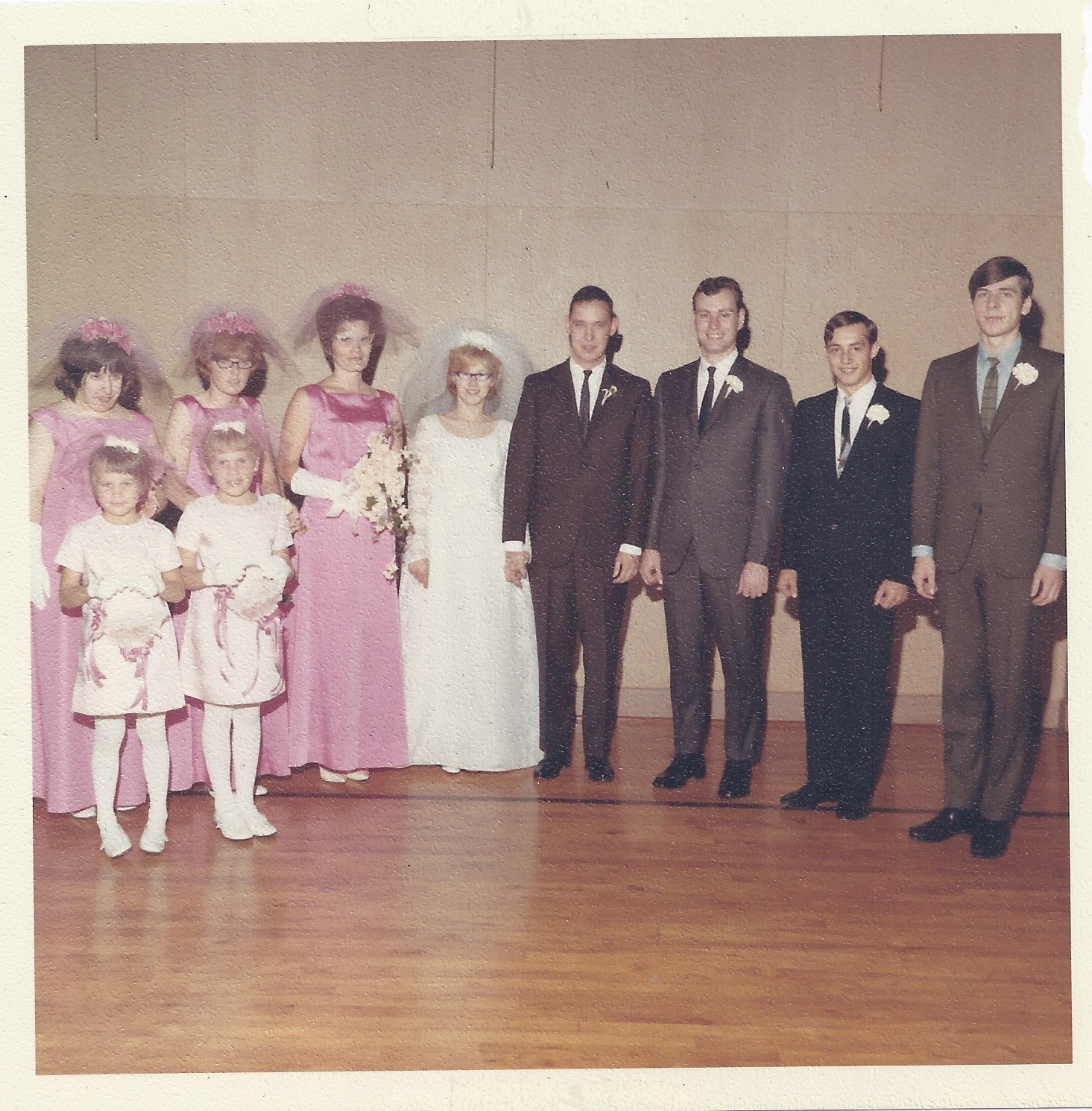
Maxine had become a part of our family but shortly after the wedding Gene began withdrawing her. She (with my help) had bought a little Datsun car that she drove to work and around. It was a pretty nice little car. Shortly after they were married it became undriveable and the withdrawal was pretty well completed.
At this same time my sister, Karen, was having more trouble with her leukemia and was in the Doernbecher children's hospital in Portland. Many days I went to school and on my way from school to work, I stopped and visited her. She was one of the sweetest in our family. She had a deep belief in Jesus. She was always in good spirits. She did talk about how she hated it when they took the bone marrow samples. I had not been around much when she was growing up since she was only about four when I left home.
She had stayed with us for a few days at a time a couple of times over the past few years and she was a joy to have around. It was sad to see her so sick at the hospital. As she got worse, my parents came and stayed with us. This was a very difficult time. I was going to school full time, working half time, our house was overloaded with Maxine and our kids and then my parents were added, we were struggling financially and they offered no help. It came close to breaking. One of the first clashes came over visiting Karen. Our parents were visiting her every day and most nights and occasionally they would want us to visit her at night so they could relax and watch the kids. The first problem came as they would tell Karen that it was for us and our doing that they had to take care of the kids so we could visit her. She didn't understand that and, of course, we were taken aback that they had told her that. Second problem was that they would make critical comments to our kids about Birdie and this caused concern with the kids and of course they asked us about it. The straw finally broke over the spaghetti. Birdie made great spaghetti and my dad ate it and expressed how much he liked it. One day they came home while Birdie was making it and he noticed some of the things he had long claimed a hatred for she was putting in it. When served, he then had my mother pick all of these things out. This was more than Birdie could take and she blew. I took my dad down to a local bar and we had a drink and I told him if he was going to stay in our house one day longer, he had to respect my wife, never criticize her in front of our kids and never criticize the food. At some point we also addressed the 'story' they were telling Karen. He stayed.
Karen passed in January 1969. The trip down to Bandon for her funeral was the worst snow storm I had seen in Oregon. I5 was stopped in Salem and chains were required going either direction. We kept chains on all the way to Winchester Bay. Before I graduated that June, Birdie had had to go to the doctor for a nervous breakdown and I had developed what I thought might be the seven-year itch. Fun times!
Graduation in June 1969 was a big event for us. It was the end of a very difficult project.
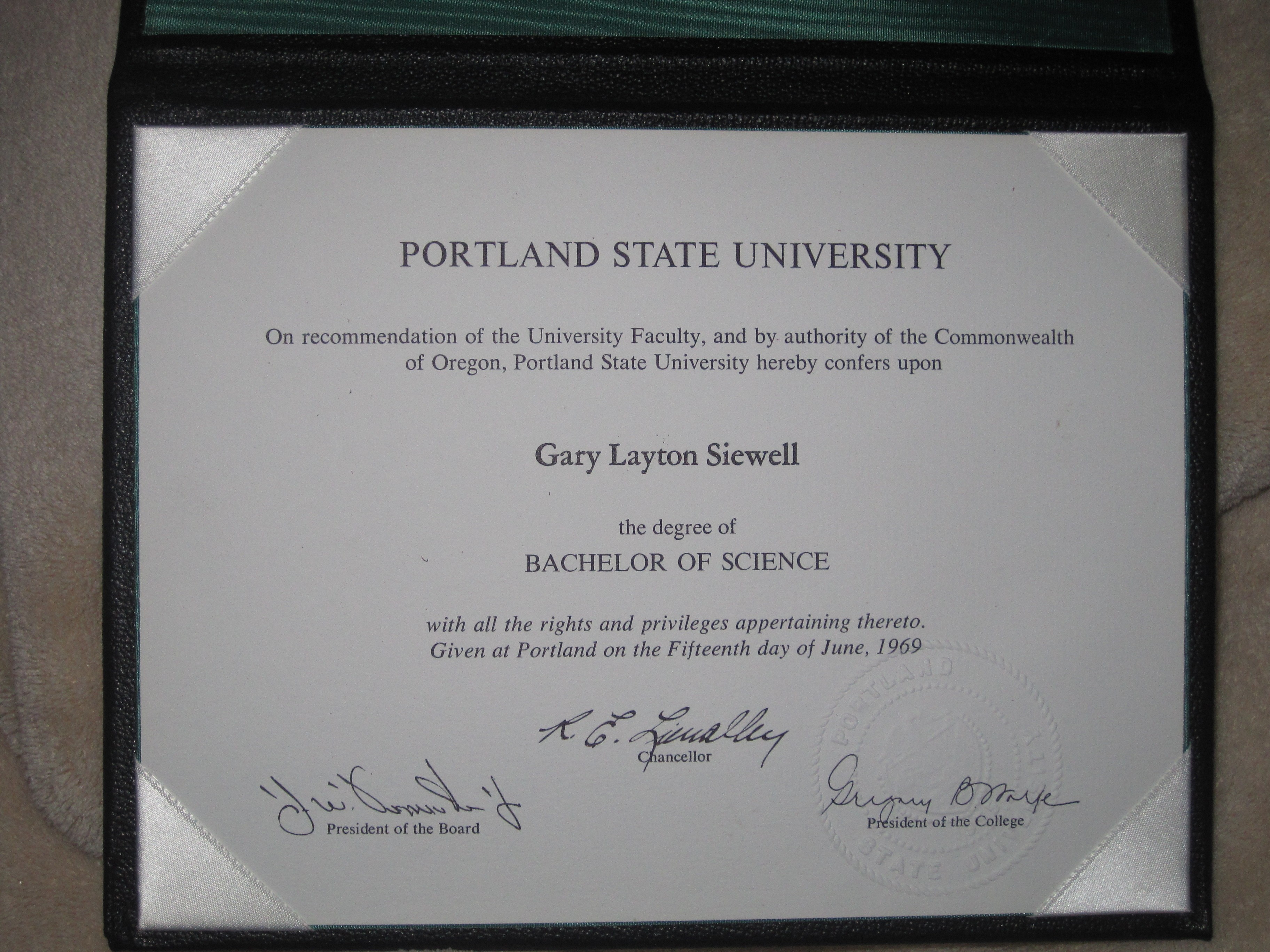
I didn't participate in the school graduation ceremony, but Grandpa and Hilda took us out for a celebration night that was fun. This was about a year before they became Mormon and may have been a last fling. We went to several different places but the most memorable was the Greek restaurant, Athens West. They had a very small dance area in the restaurant and that evening they had a belly dancer for entertainment. She invited Grandpa to join her and to show his belly dancing skills, which he did with much aplomb. We went bar hopping and had a great evening. They were the two relatives who best realized the struggle it had been for us and appreciated what we had accomplished.

Furthermore, they had faithfully attended the multitude of birthday parties we had each year and had us all over for many holidays. Mom and Dad Nettleton also appreciated what we had done. My parents said that Gilbert could have done it if he had been given a chance like me.
For those who didn't live it, I need to elaborate on the sacrifices that were made to get me through school for you to understand fully why the celebration with Grandpa and Hilda was so big for us. Such sacrifices are rare these days. Although the seed of entitlements was sown in the 1930's, WWII killed it off and the generation of our parents made huge sacrifices both during the war and after. However, the seed was sown again by Lyndon Johnson in the sixties and it took root in the 'baby boomers' generation as well as the next couple of generations and the immense wealth that had been accumulated in our country has been dissipated by entitlements, greed and stupidity. A future generation will have to pay and they won't need my explanation to understand sacrifice. Enough prophecy! The sacrifice for me to get through school wasn't so much about me. Yes, I spent a lot of hours at work and school and driving, but it was not drudgery. I was out relating to peers and talking about current events and playing bridge etc. Birdie was home every day doing routine work and taking care of children. That is what she always wanted to do and raising children is the most important task we have in our lifetimes. She took pride in it and did it well. Shopping is a bit more challenging when you do not have enough money to buy what you need and you must count the pieces of fruit and mentally divide the meat to insure everyone will have at least a healthy portion. However, even those doing what they want need a break from the routine once in a while and she rarely got that. I took summers off from school and we did some fun family things but we could count on one hand the number of times we went out to dinner or movies or any type of getting out together during the eight years I went to school. And that is why the celebration when I graduated was so important to us.
My job at Tektronix had progressed. I had demonstrated a working transfer storage CRT and an oscilloscope project had been started that would use it. I was project leader of a project to build a manufacturable transfer storage tube and start it up in production. There were essentially three subprojects with the overall project that I had to pull together: the electron gun was to be designed by an engineer, Bo Janko, in Chris Curtin's group. Mike Keegan led a group that developed the mesh mounting technique. The mesh mounting challenge was huge. It required mounting 3 electroformed mesh about a tenth inch apart in a cathode ray tube while maintaining spacing and parallelism while being processed through temperatures of about 500 degrees C. I was leading a group to design the transfer storage targets and the overall CRT assembly. I was moved pay wise to the bottom of the engineering pay with a promise from my boss, Jon Reed, that if the transfer storage tube was successfully moved into manufacturing on schedule, he would use this to justify moving me up substantially to where he and I agreed I should be. I was assigned a counterpart in Manufacturing and together we built a clean room for assembly of the storage assembly. Clean rooms were a relatively new concept and just how to do it had not yet been resolved. No blue prints were available so we built a wall of laminar flow modules on one end of the room with the idea of moving clean air through the room to take up units on the opposite wall. It worked for what we were doing but did not become the industry standard. With no more than normal hic ups and far less than many predicted (it was a very complex device) we put the product into manufacturing. Tektronix came out with a new series of oscilloscopes in 1972, one which used the old bistable storage CRT, one which used what was called variable persistence storage (a single mesh with a moderate density dielectric that would store the image for a short time that was variable since it could be traded off with brightness) and the transfer storage which was a big leap forward in writing speed. (see below article in Electronic Design in 1972)

Hewlett-Packard responded with a product that achieved about half the transfer storage writing speed by reducing the scan area in half (this increased the density of the writing beam and the accelerating voltage) and by developing an improved magnesium fluoride dielectric. Tektronix then added the reduced scan capability in a later portable storage oscilloscope and jumped the writing speed even more.
Dr McDonald was a magnificent doctor for our family for several years. He was a pioneer in radiology and a doctor in WWII. His wife was his nurse. When Michael was a few weeks old we thought he had a cold but it hung on and he had trouble breathing. When he did breathe in, his chest would collapse inward and it concerned us so Birdie took him with her to see the doctor for her six weeks check up. He asked her how quickly she could get him to the hospital. She fell apart. For a long time after that, whenever the doctor was to see the kids they would ask Birdie how soon her husband could bring the kids in. It turned out that Michael had a bigger problem and as best as I understood the doctor's diagnosis: When a baby is born the thymus gland is large and it starts shrinking. In Michael's case, the thymus did not shrink and as he grew it was cutting off his windpipe. In the hospital they put him in a tent and aspirated some new experimental drug that Dr. MacDonald had discovered in his research and had shipped in. His wife called and told us that we better get to the hospital because Michael was not expected to live. When we got to the hospital and we were headed to Michael's room, we went by the chapel and we were both inspired to go back and say a prayer in the chapel, which we did. When we left the chapel and started toward Michael's room, we ran into a nurse who was looking for us and she asked us if we were Michael's parents and when we said yes, she said, "your baby is going to live!" As you might imagine we have considered this a miracle and Michael is our miracle baby. A few years later, Doctor MacDonald got pancreatic cancer (possibly from his early work with radiation) and died. He was a great man.
My brother, Kevin, was born in 1955. Birdie and I visited Mom and him in the hospital. Mom had not taken a change of clothes with her to the hospital so we were bringing her clothes etc. in a suitcase. When the nurses saw Birdie and I coming in with a suitcase, they jumped to the wrong conclusion. Anyway, I noticed a slight blue tinge to Kevin but it was brushed off. He later became one of the first open heart surgeries in Oregon done by Dr Starr on a baby. When he was about ten, he was having some problems and Mom and Dad brought him to Portland to see the doctor. They stayed with us. The kids and I were playing some form of a baseball game in the front yard and Kevin joined in. He was really enjoying the game when he passed out. I carried him to the car and held him as Mom drove to the hospital, which was ran by the county, I believe, although possibly the state. Anyway, we got there and Kevin was still in a coma. I carried him into the hospital and my mother was trying to get him registered and looked at. They left us there holding Kevin in a coma for over 45 minutes; not even offering a bed to lay him on, let alone someone to check him to see if he needed some emergency treatment. He did not recover.
In these early years, whenever Birdie and I were going somewhere, like Bandon, we traveled in the middle of the night to enjoy low traffic and sleeping children. One time we were going on the old road from Carlton to McMinnville and just entering McMinnville and I was making good time, when the flashing lights of the police cruiser pulled up behind me. The officer came up to our car just as the kids were coming awake and as one after another's head popped up, he just said, "You can't afford a ticket so follow the speed limit from now on." That was probably the last time I ever speeded - well excessively anyway, well when Birdie was with me, well or the kids.
Another incident that happened to the English ford was when Birdie was about ready to have Paul and was driving in Beaverton, actually right next to city hall, and pulled out onto Hall blvd which was a very wide two-way, two lane street. She was turning left to go south on Hall and a teen age driver was coming north on Hall. The teen ager hit Birdie in the left rear fender just before she was had crossed the center line. So technically the fault was Birdie's but the truth was there was plenty of room for the other car to miss her and the teen ager must have just frozen and drove straight into her. We collected the insurance money for the repair and then I did a poor job of repairing it myself. It was my first, and only, experience with fiber glass. Probably a good thing.
We then traded the English Ford for a Rambler classic station wagon. It was a nice looking car. It also ran well, for a while. At this stage we were taking vacations every summer to Grants Pass. We stayed with Grandpa and Grandma Nettleton and we usually had several picnics with Gilbert's family, on weekends Gilbert joined us. We had picnics both on the Applegate River and on the Roque River @ Indian Mary park. On one occasion, we took Gilbert's kids with us to a picnic on the Applegate river where they had a rope from a tree hanging at the edge of the river so you could swing out into the river and drop off.
Of course, I had to set the example of being fearless and skillful. On another occasion, Gilbert and I (and two six packs of beer) floated on innertubes down the section of the Roque from Hog Creek County park to Indian Mary park.
The beer didn't stay with us past the first set of riffles. Probably shaken loose when we drug our butts on the rocks. We made it. However, the same cannot be said for the Rambler. Before we left Grants Pass it was making a foreboding noise but I hoped it would make it home to work on. That was not to be. On the passes just north of Grants Pass, it became louder and louder and demanded immediate attention. I stopped at a park in Canyonville and went to a service station to get some help in diagnosing it. The fellow there claimed to have been manager of the shop that maintained vehicles for the city of Los Angeles before he retired and settled in Canyonville. We concluded it was a rod bearing going out and he helped to band aid it good enough to hopefully make it home. Not to be. By the time we got past Roseburg it was clear it was not going to make it. We stopped and I called Uncle Brown in Sutherlin. He was working so I talked to Aunt Jean and she came and towed us to her house. I pulled the crankshaft out (it had been damaged) and found a used crankshaft and bought new bearings and put it back together. The bearings were too tight. I still don't know if the bearings were not the right ones or the crankshaft was not exactly the same. Uncle Brown and I thought it would loosen up with use and be okay. So, we loaded up and took off for home. However, it began to get tighter, not looser, and we called Maxine who came and towed us home. I have not had a good thought about Rambler cars since. Recently Matt was telling me he might have made a mistake in one of his car purchases; I told him whenever he feels bad about a car decision just remember the Rambler and realize that I made a worse lapse of judgment than you will ever make. I got it running enough to drive it to the car lot and traded it, the rattling engine being pretty much full disclosure about its condition. I bought a 67 red Ford Station wagon with a 390 cubic inch engine and a 4-bbl. carburetor and it turned out to be a real fine car.
Depending on my school schedule the last year and after visiting with Karen at the hospital, I would either take Bertha-Beaverton road to go home or take Sunset highway to go to work. Hard to believe now, but then Sunset highway was almost deserted from Sylvan to the turn off to Cedar Hills Blvd. I frequently turned on the western station from Hillsboro and cruised down the hill in excess of 100 mph. It was on one of these enjoyable days that they played a song that caught my ear. It was about a coming back from the war.
I didn't realize it at the time but it was Waylon Jennings. Waylon and I would have a long run. Just a day or two later they played another song from the album, Time to Bum Again.
We bought that album, Leaving Town, wore it out, bought another, wore it out and I still have the third worn out Leaving town album along with a few more we picked up along the way; almost every one Waylon put out between the late 60's to the early 80's.
In 1969, our next-door neighbor became a realtor. He wanted to list our house but we weren't interested. He persisted, so we chose what we thought was a ridiculously high price and let him list it for three months. A few days before the end of the three months, we went to Sears and invested in a top-of-the-line stereo. We knew the house had no chance of selling at that price. We wanted something that was worthy of Waylon music! Quality. I would spend hours lying on the floor next to that stereo listening to Waylon. On the last day of our listing, to our surprise and alarm, the house sold. We were in a panic finding a house to move to and getting out in time for closing.
Finding a house didn't turn out to be the hardest part. We looked at a house on Bowmont street and we loved it. It had lots of bedrooms (or bedroom possibilities), a huge family room with acoustic tile, a large white fireplace and nice large living/dining room. It was more than we had ever dreamed of. The only problem was the owners insisted on staying until school was out in May and that was several months longer than we had to get out of our house. But we took it with the idea we would rent a house in the interim. That turned out to be the hardest part. No one wanted to rent to someone who had six kids and, if one did, it would only be for a longer term (year) lease. In desperation, we rented an old white house that was so run down we were afraid to let the kids go up the stairs into the top floors. Some of the upstairs appeared to be ready to fall through at any time. Birdie and I only went up there to sleep. We crowded the kids into every nook and corner in the bottom floor. The yard was so full of dangerous debris and junk that we couldn't let the kids play in the yard. There are a few memories of this time. One, Michael was in first grade and they learned an Irish dance for St Patrick's day and Michael did the dance for us.
On not such a sterling note, Birdie and I went to a party. I parked the car facing the garage and a tree next to the garage. I proceeded to drink a bit much, uncharacteristic I might add, and when we were getting ready to leave, I pondered whether I should drive between the garage and the tree or back up and go around the tree. I finally decided, with coaching from my co-pilot, to back up and go around. Interestingly I was there a few days later for some reason and noted there was only about three feet to fit my car between the garage and the tree. Good thing I didn't try it! I also remember that the next day I was really sick all day. Probably food poisoning or I picked up a virus!
It was a tough few months and we were more than happy when May arrived and we moved in to Bowmont. We got off to a great start there. We spent a lot of time cleaning the house and then we moved in. We didn't have time to unpack everything so we stacked the boxes in the family room in the basement. We went to bed exhausted and during the night the hot water tank in the basement began to leak and flooded the entire basement. All of the boxes on the floor of the family room were soaked. It didn't get us off to a great start in the new home. But the house turned out to be a good one for us and we enjoyed it for a couple of years.
During this period of moving from Eleventh Street to Bowmont, Birdie was pregnant again. This was the first time we had the time and money to enjoy the process. Birdie painted and decorated a nursery room. Birdie and the doctor agreed on a day and time and they induced labor and she had David right on schedule. When I arrived home to tell the other kids the good news, I was greeted by a sign on the door the girls had posted which said "If it's another boy, don't bring it home!" I picked up Birdie and the baby and we made a stop at Dairy Queen and then we took him home. and it was love at first sight for all, even, maybe especially, the girls.
Back to my pay problem. By the time we had the Transfer Storage CRT started up in manufacturing and I had fulfilled my end of the bargain, Jon Reed had been promoted to a management position in a new branch of the company that had a facility in Wilsonville. Chris Curtin had been promoted to Jon's old job. I explained my bargain to Chris and he said he could give me a good boost but since he was new in his position, he wasn't willing to push for what Jon had promised. I completed work on my resume' and sent them out. Two responses stick in my mind. The first was from a branch of Litton Industries in Mountain View doing work for the space program. I was pretty interested in the job and went down for an interview. I got a rental car at the airport and started south on 101 and was amazed at the smog so thick I couldn't see the hills across the bay. I mentioned this to the interview host and he told me this was actually a pretty good day, usually the smog was worse. I told him I wouldn't move my family here. He suggested if I was serious, we cut the interview short. We did. I drove around the area and the more I did the more convinced I was I didn't want to live there.
The second was from Hewlett-Packard in Colorado Springs. Another friend of mine, Tei Iki, had left Tektronix to go to HP. Tei was Japanese and his father had been a trader in California when WWII broke out and he took his family back to Japan. One of Tei's memories of the war was the American bombers flying over where they lived. After Tei was settled at HP, he had persuaded Mike Keegan to make the move. So, both of them were in Colorado Springs when I interviewed. They both loved the area. Tei later went to work for Sony in San Diego and did really well. One of the things I most liked about HP was the openness of the work area and the fact that the managers had their desks out among the peons. Tektronix had developed a hierarchy where the highest managers were in the pent house at the top of the building (50) and on each floor below the higher managers had private offices near the windows and the lower you were the farther from the windows you had your desk. Joe Merz and I had rebelled once and moved our desks into a closet. At HP I was interviewing with CRT manufacturing and the manufacturing manager had his desk out on the floor along with everyone else's. They also offered me the same pay Jon had promised, I think it was about $1000 a month. I took it. When I gave notice to Chris, he passed the info to the Vice President of Engineering, Bill Walker. Bill knew of me as the project leader on the transfer tube and he called me to his desk. He offered to give me a little more than the HP offer. I told him that the fact that he thought I was worth that much meant they had been underpaying me and taking advantage of me for some time. I also told him keeping my word was an important principle to me and I wouldn't back out on my commitment to HP. He told me I couldn't eat my principles. That concluded my career at Tektronix.
Doctor MacDonald's wife had coined the nickname of "Pauli Wally Doodle" for Paul and it had stuck. One of the boys Paul's age on Bowmont heard us calling him that and not knowing this was just a nickname, came over and asked if "Doodle" could play.
The Bowmont house had a fenced back yard with a nice gravenstein apple tree and a nice deck. We were eating apples from the tree the day we left.
Sometime during our time at Bowmont, we wrecked the red station wagon. I was driving and going through a green light. A young lady with a car load was coming the other way and intending to make a left turn at the intersection. She mistakenly looked at the wrong light (the turn light was red) and saw green and turned in front of me. Crash!
I got a blue 68 Ford station wagon in exchange but it was not the car the red one was.
One of the issues around our moving to Colorado after I had accepted the HP offer was whether I should go first and bring the family later or we should all go together. I talked with HP personnel department about ease of finding a house to rent for our family. I explained to them that we wanted to rent for a few months so we could decide which part of Colorado Springs we wanted to live in. They assured me that renting would be no problem and that they could find us something before we even got there. So, we decided to make the venture together. When the truck came to load our stuff, I still hadn't heard from HP about a house so I called again. They said they hadn't looked for one yet but it was no problem, there were lots of houses for rent. We spent our last night in Bowmont on the floor, all the furniture was on its way to Colorado.
LINK TO CHAPTER SIX
CH6_story
LINK TO TABLE OF CONTENTS
Let Us Learn Table of Contents